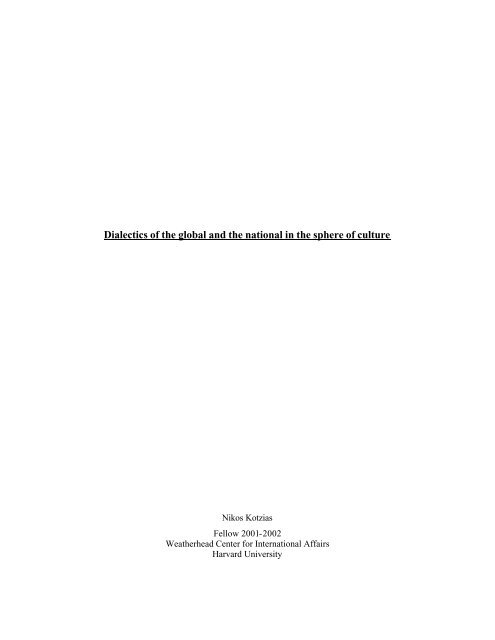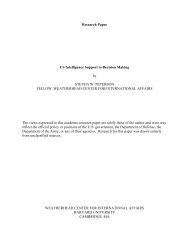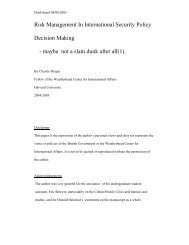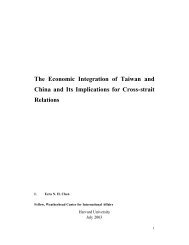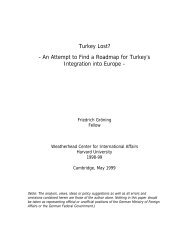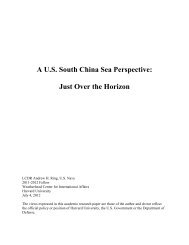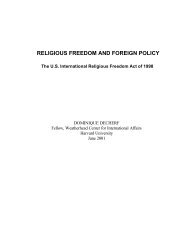Dialectics of the global and the national in the sphere of culture
Dialectics of the global and the national in the sphere of culture
Dialectics of the global and the national in the sphere of culture
Create successful ePaper yourself
Turn your PDF publications into a flip-book with our unique Google optimized e-Paper software.
<strong>Dialectics</strong> <strong>of</strong> <strong>the</strong> <strong>global</strong> <strong>and</strong> <strong>the</strong> <strong>national</strong> <strong>in</strong> <strong>the</strong> <strong>sphere</strong> <strong>of</strong> <strong>culture</strong><br />
Nikos Kotzias<br />
Fellow 2001-2002<br />
Wea<strong>the</strong>rhead Center for Inter<strong>national</strong> Affairs<br />
Harvard University
<strong>Dialectics</strong> <strong>of</strong> <strong>the</strong> <strong>global</strong> <strong>and</strong> <strong>the</strong> <strong>national</strong> <strong>in</strong> <strong>the</strong> <strong>sphere</strong> <strong>of</strong> <strong>culture</strong><br />
1. Introduction: 3 separates stereotypes<br />
The majority <strong>of</strong> discourses on <strong>global</strong>ization are underp<strong>in</strong>ned by certa<strong>in</strong><br />
stereotypes that I call <strong>the</strong> “<strong>global</strong> arguments”, because <strong>the</strong>y permeate <strong>the</strong> <strong>global</strong><br />
discourse as a whole. It is <strong>the</strong>se types <strong>of</strong> arguments, like <strong>the</strong> one I call <strong>the</strong> “historic<br />
argument”, which relates to <strong>the</strong> history <strong>of</strong> <strong>global</strong>ization, <strong>and</strong> <strong>the</strong> nation centric<br />
argument, which relates to <strong>the</strong> future fate <strong>of</strong> <strong>the</strong> nation-state, that I explore <strong>in</strong> my<br />
forthcom<strong>in</strong>g book: “Global Arguments: The History <strong>of</strong> Globalization <strong>and</strong> <strong>the</strong> Fate <strong>of</strong><br />
<strong>the</strong> Nation-State”. These k<strong>in</strong>ds <strong>of</strong> stereotypes also characterize what I call <strong>in</strong> ano<strong>the</strong>r<br />
upcom<strong>in</strong>g book “<strong>the</strong> <strong>national</strong> atmo<strong>sphere</strong>s on <strong>global</strong>ization”. Here “Atmo<strong>sphere</strong>”<br />
refers to <strong>the</strong> feel<strong>in</strong>gs, political <strong>culture</strong>, scientific discourses, eve ryday consciousness<br />
<strong>and</strong> political strategies towards <strong>global</strong>ization.<br />
Caught amongst <strong>the</strong>se <strong>global</strong> arguments <strong>and</strong> <strong>the</strong> <strong>national</strong> atmo<strong>sphere</strong>s, are<br />
series <strong>of</strong> <strong>global</strong> stereotypes, set <strong>of</strong>f by <strong>the</strong>ir <strong>national</strong> character, which make up certa<strong>in</strong><br />
<strong>in</strong>termediary discourses. The latter relates to <strong>the</strong> development <strong>of</strong> <strong>culture</strong> <strong>in</strong> <strong>the</strong> era <strong>of</strong><br />
<strong>global</strong>isation. The views are constructed upon a dualism which sees <strong>global</strong>ization<br />
ei<strong>the</strong>r as push<strong>in</strong>g towards <strong>the</strong> homogenization <strong>of</strong> <strong>culture</strong> or towards <strong>the</strong> fragmentation<br />
<strong>and</strong> conflict betwixt <strong>and</strong> between <strong>culture</strong>s. Several <strong>the</strong>orists believe that today’s<br />
cultural <strong>in</strong>teractions are constructed with reference to <strong>the</strong> “cultural homogenization<br />
<strong>and</strong> <strong>the</strong> cultural heterogenization” (Appadurai 1990).<br />
Those who refer to <strong>the</strong> homogenization <strong>of</strong> <strong>culture</strong> <strong>of</strong>ten <strong>in</strong>correctly, identify it<br />
with <strong>the</strong> tendency to create a s<strong>in</strong>gle <strong>global</strong> <strong>culture</strong>, which will go on to constitute <strong>the</strong><br />
<strong>culture</strong> <strong>in</strong> <strong>the</strong> era <strong>of</strong> <strong>global</strong>ization.<br />
On <strong>the</strong> o<strong>the</strong>r h<strong>and</strong>, with<strong>in</strong> <strong>the</strong> heterogenization rhetoric, Fea<strong>the</strong>rstone (1996) is<br />
correct <strong>in</strong> ascerta<strong>in</strong><strong>in</strong>g that <strong>the</strong> supporters <strong>of</strong> <strong>the</strong> homogenization argument fail to take<br />
<strong>in</strong>to account <strong>the</strong> fact that <strong>the</strong> supra<strong>national</strong> players operate <strong>in</strong> specific countries <strong>and</strong><br />
use dist<strong>in</strong>guished strategies. The heterogenization argument tends to recognize <strong>the</strong><br />
tendency for heterogenization to be predom<strong>in</strong>ant <strong>and</strong> <strong>in</strong> most <strong>of</strong> its variations;<br />
particularly those <strong>the</strong>ories that refer to a conflict <strong>of</strong> <strong>culture</strong>s, which holds out to any
eference to notions <strong>of</strong> a <strong>global</strong>ized <strong>culture</strong> as it rejects <strong>the</strong> existence <strong>of</strong> a s<strong>in</strong>gle <strong>global</strong><br />
<strong>culture</strong> 1 .<br />
In this essay, we will try to dist<strong>in</strong>guish between <strong>global</strong> <strong>and</strong> <strong>global</strong>ized <strong>culture</strong><br />
<strong>and</strong> <strong>in</strong>vestigate <strong>the</strong>ir dialectic <strong>in</strong>terrelation with <strong>culture</strong>s that develops with<strong>in</strong> a<br />
<strong>national</strong> space.<br />
The significance <strong>of</strong> our undertak<strong>in</strong>g lies <strong>in</strong> <strong>the</strong> politics that underlie <strong>the</strong><br />
discussions on <strong>the</strong> <strong>global</strong> <strong>and</strong>/ or <strong>the</strong> <strong>global</strong>ized <strong>culture</strong>. The homogenization <strong>the</strong>sis<br />
talks <strong>of</strong> <strong>the</strong> enforced <strong>in</strong>stallation, worldwide, <strong>of</strong> one particular <strong>culture</strong>, that <strong>of</strong> <strong>the</strong><br />
United States thus, equat<strong>in</strong>g <strong>the</strong> advocacy <strong>of</strong> a <strong>national</strong>ly specific <strong>culture</strong> with <strong>the</strong><br />
struggle aga<strong>in</strong>st Amer icanisation <strong>and</strong> <strong>the</strong> extension <strong>of</strong> <strong>global</strong>isation. The<br />
heterogenization <strong>the</strong>sis suggests that fragmentation causes <strong>culture</strong> to implode, caus<strong>in</strong>g<br />
confrontation, <strong>and</strong> it stresses <strong>the</strong> need for <strong>culture</strong>s to protect <strong>the</strong>ir “purity”.<br />
Politically, both <strong>the</strong>ses come to <strong>the</strong> same conclusion, <strong>the</strong> protection <strong>of</strong> ethnic<br />
cleanl<strong>in</strong>ess/purity (not just that <strong>of</strong> cultural uniqueness) aga<strong>in</strong>st “foreign cultural<br />
<strong>in</strong>fluences”.<br />
To beg<strong>in</strong>, however, we should first <strong>in</strong>troduce <strong>the</strong> notion <strong>of</strong> asymmetry <strong>in</strong><br />
relation to <strong>global</strong>ization, as, apart from <strong>the</strong> already mentioned dualism, we consider<br />
that a number <strong>of</strong> such asymmetries create fur<strong>the</strong>r grounds for confrontation.<br />
2. Asymmetries<br />
2.1. The notion <strong>of</strong> asymmetry<br />
The notion <strong>of</strong> asymmetry is <strong>in</strong>troduced <strong>in</strong> order to help better underst<strong>and</strong><br />
<strong>global</strong>ization as a complex phenomenon that stems from <strong>the</strong> compression <strong>of</strong> time /<br />
space <strong>and</strong> a change <strong>of</strong> <strong>the</strong> relationship between human be<strong>in</strong>g <strong>and</strong> nature which<br />
transcends societies, particularly <strong>the</strong> most advanced. This latter notion reflects <strong>the</strong><br />
unequal development <strong>of</strong> <strong>the</strong> parts <strong>of</strong> a Hegelian totality <strong>in</strong> which different parts <strong>of</strong> <strong>the</strong><br />
totality are subject to <strong>the</strong> agency <strong>of</strong> <strong>the</strong> central <strong>and</strong> secondary tendencies as well as<br />
that <strong>of</strong> <strong>the</strong> counterweight tendencies. The <strong>in</strong>tensity with which this applies to an<br />
<strong>in</strong>dividual phenomenon or to a cluster <strong>of</strong> phenomena varies. Thus, both <strong>the</strong>matically<br />
1<br />
The rejection can be direct or <strong>in</strong>direct. Hunt<strong>in</strong>gton, <strong>in</strong> his latest contribution, rejects it<br />
<strong>in</strong>directly by referr<strong>in</strong>g to ‘many <strong>global</strong>izations’ with<strong>in</strong> <strong>the</strong> realm <strong>of</strong> <strong>culture</strong> ( Berger <strong>and</strong><br />
Hunt<strong>in</strong>gton, 2002)
<strong>and</strong> geographically, <strong>the</strong> tendency towards <strong>global</strong>ization is varied with regard to its<br />
<strong>in</strong>tensity.<br />
As will be shown elsewhere, <strong>in</strong> exam<strong>in</strong><strong>in</strong>g <strong>the</strong> historic argument, each period<br />
or phase <strong>of</strong> <strong>the</strong> development <strong>of</strong> human society is characterised by <strong>the</strong> existence <strong>of</strong><br />
central tendencies, which are <strong>of</strong> pivotal significance to <strong>the</strong> given period. Such<br />
tendencies (like <strong>the</strong> tendency <strong>of</strong> <strong>global</strong>ization) coexist with peripheral tendencies (like<br />
<strong>the</strong> tendency <strong>of</strong> <strong>the</strong> <strong>in</strong>ternal marg<strong>in</strong>alization <strong>of</strong> nation-states), which can move <strong>in</strong> <strong>the</strong><br />
same but also <strong>in</strong> conflict<strong>in</strong>g directions (like <strong>the</strong> tendency <strong>of</strong> segmentation). These<br />
tendencies coexist with past tendencies but also with new ones, which will displace<br />
<strong>the</strong> current ones by assum<strong>in</strong>g significance (a matter for <strong>the</strong> future historian). The<br />
existence <strong>of</strong> such multiple tendencies creates asymmetries. Asymmetries <strong>of</strong> this k<strong>in</strong>d<br />
also exist <strong>in</strong> <strong>the</strong> realm <strong>of</strong> <strong>culture</strong>, <strong>in</strong> <strong>the</strong> relations between <strong>the</strong> particular <strong>and</strong> <strong>the</strong><br />
general, <strong>the</strong> <strong>national</strong> <strong>and</strong> <strong>the</strong> <strong>global</strong>.<br />
2.2. Spatial Asymmetry<br />
The existence <strong>of</strong> asymmetries with<strong>in</strong> a dom<strong>in</strong>ant tendency, like <strong>global</strong>ization,<br />
does not <strong>in</strong> any way disprove <strong>the</strong> existence <strong>of</strong> that tendency per se. It cannot be<br />
argued that if, say, capitalism or <strong>global</strong>ization, for that matter, are not prevalent<br />
throughout, <strong>the</strong>y do not exist. Geographical asymmetry -that is, <strong>the</strong> fact that <strong>the</strong>re<br />
exist countries that are more vigorous <strong>global</strong>ization players than o<strong>the</strong>rs - cannot<br />
dim<strong>in</strong>ish its significance as <strong>the</strong> dom<strong>in</strong>ant tendency. Some countries have made<br />
significant contributions to <strong>the</strong> process <strong>of</strong> <strong>global</strong>ization, by shap<strong>in</strong>g it <strong>and</strong> promot<strong>in</strong>g<br />
it, o<strong>the</strong>rs have come <strong>in</strong> later <strong>and</strong> sought to consciously <strong>in</strong>fluence <strong>the</strong> ideations <strong>of</strong><br />
<strong>global</strong>ization; <strong>and</strong> <strong>the</strong>re are still countries that are more placid towards it. This can<br />
also be argued across <strong>the</strong> different <strong>culture</strong>s.<br />
The differences that underlie <strong>the</strong> distribution <strong>and</strong> <strong>the</strong> <strong>in</strong>tensity <strong>of</strong> <strong>global</strong>isation<br />
across <strong>the</strong> different geographical spaces do not mean it does not exist on <strong>the</strong> whole or<br />
that it is a secondary event. Such reason<strong>in</strong>g would suggest that s<strong>in</strong>ce capitalism is not<br />
predom<strong>in</strong>ant everywhere, we are not currently liv<strong>in</strong>g through an era <strong>of</strong> capitalism. Or<br />
even that s<strong>in</strong>ce <strong>the</strong> tendency for <strong>global</strong>ization is more vibrant <strong>in</strong> <strong>the</strong> United States than<br />
<strong>in</strong> Somalia, <strong>global</strong>ization does not exist. Such reason<strong>in</strong>g would <strong>in</strong> Fact suggest that<br />
our era is not characterised by its most dom<strong>in</strong>ant sides but by its poorest <strong>and</strong> weakest.
In order to protect <strong>the</strong> dom<strong>in</strong>ance <strong>of</strong> a tendency, on <strong>the</strong> o<strong>the</strong>r h<strong>and</strong>, one should not<br />
refra<strong>in</strong> from recognis<strong>in</strong>g <strong>the</strong> negative sides, <strong>the</strong> conflict<strong>in</strong>g elements or its ‘vacuums’.<br />
One can argue that <strong>in</strong> <strong>the</strong> era <strong>of</strong> <strong>global</strong>isation, both wealth <strong>and</strong> poverty are produced<br />
<strong>and</strong> alongside <strong>the</strong> tendency for <strong>global</strong>ization one comes across <strong>the</strong> counterbalanc<strong>in</strong>g<br />
tendencies <strong>of</strong> segmentation <strong>and</strong> fragme ntation. Such phenomena, though, like<br />
poverty, segmentation, <strong>national</strong>ism, racism <strong>and</strong> xenophobia, do not occur<br />
irrespectively <strong>of</strong> <strong>global</strong>isation. On <strong>the</strong> contrary, <strong>the</strong>y are created with<strong>in</strong> this<br />
predom<strong>in</strong>ant tendency to counterbalance it. Thus a particular type <strong>of</strong> segmentation<br />
<strong>and</strong> fragmentation, <strong>of</strong> <strong>national</strong>ism <strong>and</strong> <strong>of</strong> ill-perceived localism, are created as a result<br />
<strong>of</strong> <strong>the</strong> predom<strong>in</strong>ation <strong>of</strong> <strong>global</strong>isation ra<strong>the</strong>r than as a result <strong>of</strong> its absence.<br />
A fur<strong>the</strong>r characteristic <strong>of</strong> <strong>global</strong>isation is <strong>the</strong> disruption it causes to <strong>the</strong><br />
<strong>in</strong>ternal structures <strong>of</strong> each country. This disruption takes place accord<strong>in</strong>g to different<br />
k<strong>in</strong>ds <strong>of</strong> asymmetries <strong>in</strong> each country. Globalization affects larger sections <strong>of</strong> <strong>the</strong><br />
population, <strong>of</strong> <strong>the</strong> economy, <strong>of</strong> <strong>the</strong> social structures <strong>and</strong> relations <strong>in</strong> <strong>the</strong> most pow erful<br />
<strong>and</strong> rich nations than <strong>in</strong> <strong>the</strong> poorer <strong>and</strong> less powerful. Even <strong>in</strong> <strong>the</strong> latter however, one<br />
f<strong>in</strong>ds sections <strong>of</strong> <strong>the</strong> predom<strong>in</strong>ant groups <strong>of</strong> <strong>the</strong> population as well as specific aspects<br />
<strong>of</strong> <strong>the</strong> economy that are emerged <strong>in</strong> <strong>the</strong> most vigorous sides <strong>of</strong> <strong>global</strong>ization.<br />
On <strong>the</strong> o<strong>the</strong>r h<strong>and</strong>, fragmentation is very much an <strong>in</strong>tr<strong>in</strong>sic characteristic <strong>of</strong> <strong>the</strong><br />
socio-economic, political <strong>and</strong> everyday life <strong>of</strong> each nation-state <strong>and</strong> <strong>of</strong> each society.<br />
Therefore, <strong>the</strong> supra<strong>national</strong> asymmetries can also be <strong>in</strong>tr<strong>in</strong>sically <strong>in</strong>troduced.<br />
This is also true with regard to <strong>culture</strong>. The more vibrant <strong>the</strong> cultural traditions<br />
<strong>and</strong> context <strong>of</strong> a <strong>national</strong> space, <strong>the</strong> more <strong>the</strong> <strong>global</strong>ly predom<strong>in</strong>ant tendencies will be<br />
‘coated’ <strong>in</strong> <strong>national</strong> colours. Accord<strong>in</strong>gly, with<strong>in</strong> each country, one can make out a<br />
variety <strong>of</strong> tendencies that orig<strong>in</strong>ate from <strong>the</strong> country’s own tradition (which has never,<br />
<strong>in</strong> its own right, been 100% pure), from external <strong>in</strong>fluences or from a comb<strong>in</strong>ation <strong>of</strong><br />
both.<br />
2.3 The Social-Time Segmentation<br />
Globalization effects are not symmetrical for all nation-states, <strong>the</strong> social<br />
groups that make <strong>the</strong>m up, <strong>the</strong> branches <strong>and</strong> sectors <strong>of</strong> society <strong>and</strong> economy, or for<br />
<strong>in</strong>dividuals <strong>the</strong>mselves. There rema<strong>in</strong>s <strong>the</strong> fact, however, that <strong>the</strong> process <strong>of</strong> social<br />
segmentation is more substantial than that that <strong>of</strong> economic segme ntation. This is<br />
expressed <strong>in</strong> <strong>the</strong> dialectic <strong>of</strong> homogenization <strong>and</strong> heterogenization, which we will
look <strong>in</strong>to <strong>in</strong> <strong>the</strong> chapter 3 on <strong>the</strong> development <strong>of</strong> <strong>culture</strong>. It is ma<strong>in</strong>ly expressed<br />
through <strong>the</strong> manifestation <strong>of</strong> certa<strong>in</strong> tendencies, <strong>in</strong>cl<strong>in</strong>ations <strong>and</strong> attitudes aga<strong>in</strong>st<br />
<strong>global</strong>ization, which are not oppos<strong>in</strong>g <strong>the</strong> forms it takes but have ra<strong>the</strong>r more to do<br />
with <strong>the</strong> worldwide birth <strong>of</strong> movements <strong>of</strong> dis<strong>in</strong>tegration (like religion<br />
fundamentalisms, xenophobia, regionalism, new <strong>national</strong>ism). This is not simply a<br />
negation <strong>of</strong> <strong>global</strong>ization but ra<strong>the</strong>r a negation <strong>of</strong> anyth<strong>in</strong>g different or foreign. A<br />
negation that stems from <strong>global</strong>ization <strong>and</strong> its processes: <strong>the</strong> mobility <strong>of</strong> capital,<br />
goods, services <strong>and</strong> people <strong>and</strong> <strong>the</strong> exchange <strong>of</strong> images, messages, perceptions <strong>and</strong><br />
<strong>culture</strong>. The basic phenomena <strong>of</strong> a dis<strong>in</strong>tegration <strong>of</strong> this sort are expressed via a<br />
fanaticism, which is based on religion, <strong>national</strong>ism or stereotypes. It can also be<br />
expressed via an idiosyncratic cultural <strong>national</strong>ism, where one’s <strong>national</strong> ideas,<br />
images, sounds <strong>and</strong> values are considered more important than those <strong>of</strong> <strong>the</strong> o<strong>the</strong>r.<br />
Today, one comes across four currents towards <strong>global</strong>ization. The first one<br />
bows to <strong>global</strong>ization <strong>in</strong> its current form <strong>and</strong> aims to promote it, albeit with some<br />
transformations. Here, anyth<strong>in</strong>g foreign is seen as worthy <strong>of</strong> one’s attention.<br />
Culturally, this leads to prov<strong>in</strong>cialism. The second current wishes to alter<br />
<strong>global</strong>ization’s form. This is <strong>the</strong> <strong>culture</strong> <strong>of</strong> “copy<strong>in</strong>g”, characterised by <strong>the</strong> lack <strong>of</strong><br />
orig<strong>in</strong>ality. The third aims to change many <strong>of</strong> <strong>global</strong>ization’s characteristics. It wants<br />
to promote elements <strong>of</strong> <strong>the</strong> <strong>national</strong> <strong>culture</strong> <strong>in</strong> supra<strong>national</strong> spaces. F<strong>in</strong>ally, <strong>the</strong> fourth<br />
opposes any phenomenon, structure, relationship or essence that creates or re<strong>in</strong>forces<br />
<strong>the</strong> tendency for <strong>global</strong>ization. The struggle aga<strong>in</strong>st it is nei<strong>the</strong>r aimed at acquir<strong>in</strong>g a<br />
par share <strong>of</strong> cultural participation nor at <strong>in</strong>fluenc<strong>in</strong>g it but ra<strong>the</strong>r at return<strong>in</strong>g to <strong>the</strong><br />
<strong>national</strong> past. It is aimed at defend<strong>in</strong>g <strong>the</strong> <strong>national</strong>ly particular aga<strong>in</strong>st anyth<strong>in</strong>g<br />
foreign.<br />
The tendency <strong>of</strong> today’s world, towards dis<strong>in</strong>tegration, results from a<br />
multiplicity <strong>of</strong> factors. The most characteristic is <strong>the</strong> sense that <strong>global</strong>isation creates<br />
new problems which become unsolvable for those <strong>in</strong>volved; <strong>the</strong> sense that <strong>the</strong> exist<strong>in</strong>g<br />
differences are be<strong>in</strong>g lost; that <strong>the</strong>re is a need for one to defend his cultural<br />
uniqueness, <strong>the</strong> <strong>culture</strong>, <strong>the</strong> traditions <strong>and</strong> <strong>the</strong> history <strong>of</strong> <strong>the</strong> space one reflects. This<br />
makes sense if one takes <strong>in</strong>to account that one cannot prepare for change, for<br />
assess<strong>in</strong>g <strong>the</strong> difficulties that occur <strong>and</strong> for turn<strong>in</strong>g change to his advantage, without<br />
us<strong>in</strong>g <strong>the</strong> past <strong>in</strong> order to be able to foresee <strong>the</strong> future. Without a sense <strong>of</strong> history,<br />
mank<strong>in</strong>d becomes what I call a victim <strong>of</strong> leap<strong>in</strong>g <strong>in</strong> <strong>the</strong> vacuum <strong>of</strong> ignorance. At <strong>the</strong>
same time, concentration on <strong>the</strong> past can sometimes be blamed for trapp<strong>in</strong>g one <strong>in</strong> its<br />
specificities, <strong>and</strong> thus conf<strong>in</strong><strong>in</strong>g one <strong>in</strong> history.<br />
Today, <strong>the</strong>re are people, social groups, movements <strong>and</strong> societies that f<strong>in</strong>d<br />
<strong>the</strong>mselves trapped <strong>in</strong> this sort <strong>of</strong> attitude; that is, societies that are caught up <strong>in</strong> <strong>the</strong><br />
past, which do not face <strong>the</strong> future <strong>and</strong> negotiate <strong>the</strong> issues that arise from<br />
<strong>global</strong>ization, <strong>the</strong> new problems it <strong>in</strong>curs, <strong>and</strong> <strong>the</strong> way it readdresses issues from <strong>the</strong><br />
past. In fact, <strong>the</strong>y tend to ignore <strong>global</strong>isation as <strong>the</strong>y strive to defend <strong>the</strong>ir cultural<br />
heritage, <strong>in</strong> an attempt to shield <strong>the</strong>mselves from <strong>the</strong> unknown (that is what happens<br />
<strong>in</strong> many Arabs countries <strong>and</strong> by <strong>the</strong> so called orthodox Jews). Societies need to accept<br />
that <strong>the</strong>ir cultural heritage can constitute a significant wealth for humanity as a whole;<br />
<strong>in</strong> order to do so, however, it needs to be supra<strong>national</strong>ly exploited <strong>and</strong> turned to good<br />
account. The <strong>national</strong> spaces need to accept this dialectic, <strong>in</strong> order to avoid <strong>the</strong><br />
creation <strong>of</strong> conditions that will leave <strong>the</strong>m caught <strong>in</strong> a rift between <strong>the</strong> past <strong>and</strong> <strong>the</strong><br />
future. This is a rift between <strong>culture</strong>s that look forward to develop<strong>in</strong>g <strong>and</strong> those which<br />
are trapped <strong>in</strong> <strong>the</strong> past; a past <strong>the</strong>y try to glorify, defend <strong>and</strong> espouse to, as <strong>in</strong> <strong>the</strong> cases<br />
<strong>of</strong> religious fanaticism that one comes across both <strong>in</strong> <strong>the</strong> Muslim <strong>and</strong> <strong>the</strong> Christian<br />
world. And, vic e versa, one also comes across fanatics who concentrate on<br />
discont<strong>in</strong>uity <strong>and</strong> promote <strong>the</strong> new, ignor<strong>in</strong>g <strong>the</strong> unsolved problems that stem from<br />
<strong>the</strong> past, <strong>the</strong> social asymmetries <strong>and</strong> conflicts, as well as <strong>the</strong> wealth which is enclosed<br />
<strong>in</strong> tradition <strong>and</strong> can help <strong>in</strong> both solv<strong>in</strong>g future problems <strong>and</strong> <strong>in</strong> enrich<strong>in</strong>g <strong>the</strong> future<br />
itself.<br />
In <strong>the</strong> centre <strong>of</strong> this struggle between <strong>the</strong> past <strong>and</strong> <strong>the</strong> future lies <strong>the</strong> issue <strong>of</strong><br />
identity. There are those personalities, social groups, <strong>and</strong> nations who are afraid that<br />
<strong>the</strong>y will be displaced <strong>and</strong> left without a role to play. They are <strong>the</strong> ones that seek to<br />
def<strong>in</strong>e <strong>the</strong>ir identity with relation to <strong>the</strong> past, <strong>in</strong> strict opposition to <strong>the</strong> novel, which<br />
may not be new to humanity but only to <strong>in</strong>dividual experiences. Fear <strong>and</strong> rivalry<br />
towards <strong>the</strong> foreign are born out <strong>of</strong> try<strong>in</strong>g to ascerta<strong>in</strong> <strong>and</strong> confirm one’s identity<br />
along <strong>the</strong>se l<strong>in</strong>es, by concentrat<strong>in</strong>g on defend<strong>in</strong>g one’s <strong>in</strong>dividuality no matter what<br />
(fundamentalism).<br />
It is <strong>of</strong> course natural for nation-states <strong>and</strong> social groups, which see <strong>the</strong> decl<strong>in</strong>e<br />
<strong>of</strong> <strong>the</strong>ir economic <strong>and</strong> social power or <strong>the</strong>ir political clout (both <strong>in</strong>ter<strong>national</strong>ly <strong>and</strong><br />
<strong>national</strong>ly) <strong>and</strong> <strong>the</strong> demission <strong>of</strong> <strong>the</strong>ir cultural characteristics to react negatively<br />
towards <strong>global</strong>ization. We <strong>the</strong>refore see <strong>the</strong> emergence <strong>of</strong> <strong>the</strong> most dist<strong>in</strong>ct<br />
movements <strong>of</strong> opposition <strong>and</strong> resistance aga<strong>in</strong>st ei<strong>the</strong>r <strong>global</strong>ization per se (like <strong>the</strong>
Muslim fanatical movements or extreme fascistic <strong>national</strong>ism) or particular processes<br />
<strong>of</strong> it (from certa<strong>in</strong> movements <strong>and</strong> leftw<strong>in</strong>g parties). This type <strong>of</strong> reaction is<br />
particularly common <strong>in</strong> <strong>the</strong> realm <strong>of</strong> <strong>culture</strong>: one <strong>of</strong>ten sees such animosity towards<br />
<strong>global</strong>ization expressed via direct attacks on symbols, images <strong>and</strong> ways <strong>of</strong> life (such<br />
as <strong>the</strong> eat<strong>in</strong>g habits – versus Macdonaldisation <strong>of</strong> <strong>the</strong> world).<br />
3. Is <strong>the</strong>re a <strong>global</strong> unified <strong>culture</strong><br />
3.1 Introduction<br />
Many <strong>of</strong> <strong>the</strong> societies that are opposed to <strong>global</strong>ization constantly <strong>in</strong>voke <strong>the</strong>ir<br />
cultural uniqueness as well as <strong>the</strong> belief that <strong>global</strong>ization is a Trojan horse for <strong>the</strong><br />
Americanisation <strong>of</strong> <strong>the</strong> world.<br />
Accord<strong>in</strong>g to this view, Americanisation ta kes place not only through <strong>the</strong><br />
economy but also predom<strong>in</strong>antly through <strong>the</strong> homogenization <strong>of</strong> <strong>global</strong> <strong>culture</strong> under<br />
<strong>the</strong> hegemony <strong>of</strong> <strong>the</strong> American <strong>culture</strong>. The underly<strong>in</strong>g logic po<strong>in</strong>ts to <strong>the</strong> equation <strong>of</strong><br />
<strong>global</strong>ization with Americanisation. The latter is chiefly seen as a cultural<br />
phenomenon <strong>and</strong> thus <strong>the</strong> promotion <strong>of</strong> its dom<strong>in</strong>ation po<strong>in</strong>ts to <strong>the</strong> cultural<br />
homogenization <strong>of</strong> <strong>the</strong> world.<br />
The literature <strong>of</strong> <strong>the</strong> most disparate views <strong>of</strong>ten refers to <strong>the</strong> homogenization<br />
<strong>of</strong> <strong>culture</strong> through Americanisation. This is so much <strong>in</strong> <strong>the</strong> writ<strong>in</strong>gs <strong>of</strong> those who<br />
promote ‘total <strong>global</strong>ization’ (who believe <strong>the</strong> world is be<strong>in</strong>g homogenized at its<br />
optimum), as <strong>in</strong> <strong>the</strong> writ<strong>in</strong>gs <strong>of</strong> those who oppose <strong>global</strong>ization per se (who believe<br />
<strong>the</strong>y should fight its cultural implications). The most antagonistic views reach <strong>the</strong><br />
same conclusion: Today’s world is undergo<strong>in</strong>g a process <strong>of</strong> cultural homogenization<br />
as a result <strong>of</strong> <strong>global</strong>ization. Some support <strong>and</strong> encourage it, as homogenization is<br />
perceived to take place at <strong>the</strong> highest possible level <strong>of</strong> prosperity, while o<strong>the</strong>rs are set<br />
on dissuad<strong>in</strong>g it when it is perceived to obliterate history <strong>and</strong> tradition, <strong>the</strong> <strong>national</strong><br />
<strong>and</strong> <strong>the</strong> local spaces (U. Beck 1998, Barber 1996).<br />
These two anti<strong>the</strong>tical views effectively adopt a common rhetoric; that <strong>the</strong>re<br />
exists a <strong>global</strong> <strong>culture</strong> <strong>of</strong> homogenization accord<strong>in</strong>g to <strong>the</strong> American model. We<br />
consider both <strong>the</strong>se views to be flawed, as both perceive <strong>global</strong> <strong>culture</strong> as someth<strong>in</strong>g<br />
one-dimensional <strong>and</strong> not as a unity <strong>of</strong> anti<strong>the</strong>tical <strong>and</strong> peripheral forms.
Our fundamental argument is that <strong>the</strong>re exists dialectic <strong>of</strong> <strong>national</strong> <strong>and</strong> local<br />
<strong>culture</strong>s <strong>and</strong> <strong>global</strong>iz<strong>in</strong>g tendencies with regard to <strong>culture</strong>. Thus <strong>global</strong> <strong>culture</strong> is not<br />
solely made up from <strong>the</strong> latter; on <strong>the</strong> contrary, it is <strong>the</strong> aggregate <strong>of</strong> <strong>the</strong>se two factors.<br />
It becomes obvious that if our <strong>culture</strong> were uniform <strong>and</strong> thus one -dimensional<br />
one would have difficulty <strong>in</strong> <strong>in</strong>terpret<strong>in</strong>g schemata like <strong>global</strong>ization- fundamentalism<br />
movements aga<strong>in</strong>st <strong>global</strong>ization, <strong>global</strong>ization <strong>and</strong> fragmentation. On <strong>the</strong> o<strong>the</strong>r<br />
h<strong>and</strong>, if <strong>the</strong> different <strong>culture</strong>s evolve parallel 2 to one ano<strong>the</strong>r without <strong>in</strong>teract<strong>in</strong>g, we<br />
would be faced with many separate <strong>and</strong> autonomous worlds <strong>and</strong> one could only speak<br />
<strong>of</strong> <strong>the</strong> processes <strong>of</strong> <strong>global</strong>ization <strong>and</strong> <strong>the</strong> notion <strong>of</strong> <strong>global</strong> <strong>culture</strong> merely as elements<br />
<strong>of</strong> this parallel evolution.<br />
Thus, as far as <strong>culture</strong> is concerned one, should aim to def<strong>in</strong>e <strong>the</strong> dialectic <strong>of</strong><br />
<strong>the</strong> <strong>global</strong> <strong>and</strong> <strong>the</strong> <strong>national</strong>, <strong>of</strong> <strong>the</strong> peripheral (<strong>national</strong>) <strong>and</strong> <strong>the</strong> central (<strong>global</strong>iz<strong>in</strong>g)<br />
tendencies.<br />
3.2 The perception <strong>of</strong> a one - dimensional <strong>culture</strong><br />
The <strong>the</strong>sis <strong>of</strong> a s<strong>in</strong>gle <strong>global</strong> <strong>culture</strong> that not only assimilates <strong>the</strong> exist<strong>in</strong>g<br />
<strong>national</strong> <strong>culture</strong>s, but ra<strong>the</strong>r disorganizes <strong>and</strong> destroys <strong>the</strong>m, is widely popular <strong>in</strong><br />
<strong>in</strong>ter<strong>national</strong> literature.<br />
Kondylis (1998) considers our era to be characterised by <strong>the</strong> transition from a<br />
mass to a <strong>global</strong> <strong>culture</strong>. Accord<strong>in</strong>g to him, this <strong>culture</strong> dis<strong>in</strong>tegrates <strong>the</strong> “preced<strong>in</strong>g<br />
folk <strong>and</strong> <strong>national</strong> <strong>culture</strong>s” <strong>in</strong>to <strong>the</strong>ir constituents, which are <strong>the</strong>n used as <strong>in</strong>gredients<br />
<strong>of</strong> “a more or less uniform <strong>global</strong> <strong>culture</strong>”. It exp<strong>and</strong>s <strong>and</strong> enforces its uniformity. In<br />
this way, it becomes uniform <strong>and</strong> <strong>global</strong>. For this reason, Kondylis concludes,<br />
“western mass <strong>culture</strong> on a universal scale” (1998, b5) becomes “<strong>the</strong> only possible<br />
<strong>global</strong> <strong>culture</strong>”.<br />
Like Spengler (1918-1922) before him, Kondylis discerns <strong>the</strong> dom<strong>in</strong>ance <strong>of</strong><br />
Western <strong>culture</strong> over <strong>the</strong> o<strong>the</strong>rs, <strong>and</strong> is this Western <strong>culture</strong> that he perceives as<br />
<strong>global</strong>iz<strong>in</strong>g. This <strong>global</strong> <strong>culture</strong> is not perceived as a <strong>culture</strong> that is made up from a<br />
creative aggregate <strong>of</strong> <strong>the</strong> exist<strong>in</strong>g <strong>culture</strong>s nor is it seen as <strong>the</strong> dialectic development<br />
<strong>of</strong> <strong>the</strong> <strong>in</strong>teractions, albeit asymmetrical, <strong>of</strong> <strong>national</strong> <strong>culture</strong>s. Ra<strong>the</strong>r, it is seen as a<br />
2<br />
This is Hunt<strong>in</strong>gton‘s argument <strong>in</strong> his writ<strong>in</strong>gs on <strong>the</strong> conflict <strong>of</strong> <strong>culture</strong>s. Effectively, <strong>the</strong><br />
<strong>the</strong>sis on <strong>the</strong> <strong>global</strong> conflict <strong>of</strong> <strong>culture</strong>s <strong>in</strong>directly rejects <strong>the</strong> process <strong>of</strong> <strong>global</strong>ization <strong>and</strong><br />
concentrates <strong>in</strong>stead on that <strong>of</strong> a restra<strong>in</strong><strong>in</strong>g <strong>and</strong> eccentric fragmentation.
<strong>global</strong> <strong>culture</strong>, which <strong>in</strong>sures <strong>the</strong> suzera<strong>in</strong>ty <strong>of</strong> one <strong>of</strong> <strong>the</strong> exist<strong>in</strong>g <strong>culture</strong>s over <strong>the</strong><br />
rest, irrespective <strong>of</strong> <strong>the</strong> fact that <strong>the</strong> dom<strong>in</strong>ant <strong>culture</strong> is itself an aggregates <strong>of</strong><br />
different expressions <strong>and</strong> may very well assimilate elements <strong>of</strong> o<strong>the</strong>rs.<br />
Both Spengler <strong>and</strong> Kondylis call this <strong>the</strong> process <strong>of</strong> imposition <strong>of</strong> western<br />
<strong>culture</strong>; <strong>the</strong> French call it <strong>the</strong> dom<strong>in</strong>ation <strong>of</strong> <strong>the</strong> American <strong>culture</strong>, whereas <strong>in</strong> <strong>the</strong><br />
Popular Republic Of Ch<strong>in</strong>a both <strong>the</strong> concepts <strong>of</strong> Westernization <strong>and</strong> Americanization<br />
are used at <strong>the</strong> same time <strong>in</strong> <strong>the</strong> same way <strong>and</strong> discourses.<br />
The above view accord<strong>in</strong>g to which <strong>the</strong> evolutionary future <strong>of</strong> contemporary<br />
<strong>culture</strong> lies <strong>in</strong> <strong>the</strong> one-dimensional spread <strong>of</strong> American <strong>global</strong>ization, dom<strong>in</strong>ates <strong>the</strong><br />
French <strong>and</strong> <strong>the</strong> Greek atmo<strong>sphere</strong>. It is even adopted (with certa<strong>in</strong> variations) by those<br />
who have come out for neoliberal <strong>global</strong>ization. It is also espoused by those Left<br />
powers that object to <strong>global</strong>isation, particularly those characterised by Eurocentrism.<br />
This view registers <strong>the</strong> bona fide tendency <strong>of</strong> <strong>the</strong> homogenization <strong>of</strong> <strong>global</strong> <strong>culture</strong><br />
under <strong>the</strong> forms <strong>and</strong> <strong>the</strong> structures <strong>of</strong> <strong>the</strong> dom<strong>in</strong>ant one. This sort <strong>of</strong> argument lacks<br />
conceptual clarity <strong>and</strong> fails to dist<strong>in</strong>guish between opposite tendencies.<br />
3.2.1. The issue <strong>of</strong> def<strong>in</strong>itions<br />
Our view, one needs to beg<strong>in</strong> by dissociat<strong>in</strong>g between a <strong>culture</strong> which holds<br />
only local clout <strong>and</strong> one with a wider, even supra<strong>national</strong> <strong>in</strong>fluence (like <strong>the</strong> Greek<br />
with<strong>in</strong> <strong>the</strong> context <strong>of</strong> <strong>the</strong> Middle East <strong>and</strong> <strong>the</strong> Balkans) 3 . Yet aga<strong>in</strong>, this sort <strong>of</strong><br />
<strong>in</strong>fluence is different to that <strong>of</strong> a <strong>culture</strong>, which tends to become <strong>global</strong>ized, i.e., has a<br />
ubiquitous presence 4 . Effectively, <strong>the</strong>re is a clear dist<strong>in</strong>ction between <strong>global</strong>ized<br />
<strong>culture</strong> <strong>and</strong> <strong>global</strong> <strong>culture</strong>.<br />
Global <strong>culture</strong> <strong>in</strong>cludes <strong>in</strong>ter<strong>national</strong>ised <strong>and</strong> <strong>global</strong>ized <strong>culture</strong>s, but also<br />
<strong>in</strong>corporates <strong>the</strong> local <strong>and</strong> <strong>national</strong> ones. Global <strong>culture</strong> is <strong>the</strong> dialectical syn<strong>the</strong>sis <strong>and</strong><br />
conjunction <strong>of</strong> <strong>global</strong>ized, local, <strong>and</strong> fragmented <strong>culture</strong>s. We consider <strong>the</strong>re to be a<br />
great difference between a <strong>culture</strong> that is undergo<strong>in</strong>g <strong>global</strong>isation <strong>and</strong> a truly <strong>global</strong><br />
3<br />
The term “glocal”, referr<strong>in</strong>g to <strong>the</strong> diffusion <strong>of</strong> <strong>the</strong> <strong>global</strong> <strong>and</strong> local elements <strong>in</strong> <strong>the</strong> context<br />
<strong>of</strong> a <strong>global</strong> <strong>culture</strong> that becomes <strong>in</strong>creas<strong>in</strong>gly fragmented, has been conjured up from <strong>the</strong><br />
fusion <strong>of</strong> <strong>the</strong> terms Global <strong>and</strong> Local. On <strong>the</strong> term “glocal” see Beck (1998) <strong>and</strong> his<br />
references, as well as, Friedrichs (1994).<br />
4<br />
For this reason, we consider <strong>the</strong> German <strong>the</strong>sis which substitutes <strong>the</strong> terms <strong>of</strong> <strong>global</strong>ization<br />
<strong>and</strong> <strong>in</strong>ter<strong>national</strong>ization with that <strong>of</strong> de<strong>national</strong>ization to be flawed. The effect <strong>of</strong> a <strong>national</strong><br />
<strong>culture</strong> on ano<strong>the</strong>r is a form <strong>of</strong> <strong>in</strong>ter<strong>national</strong>ized presence ra<strong>the</strong>r than one <strong>of</strong> de<strong>national</strong>ization.
<strong>culture</strong>, which would be <strong>the</strong> aggregate <strong>of</strong> <strong>the</strong> all <strong>the</strong> various <strong>culture</strong>s that can be found<br />
<strong>in</strong> <strong>the</strong> most diverse stages <strong>of</strong> human presence.<br />
Global <strong>culture</strong> <strong>the</strong>refore is <strong>the</strong> ensemble <strong>of</strong> <strong>the</strong> diachronic <strong>in</strong>terspatial <strong>culture</strong>s<br />
<strong>of</strong> <strong>the</strong> world. Inter<strong>national</strong>ised <strong>culture</strong> is that which transcends <strong>the</strong> <strong>national</strong> space<br />
where it was formulated (e.g. Western classical music has) <strong>and</strong> affects parts <strong>of</strong> o<strong>the</strong>r<br />
nation’s societies; whereas <strong>global</strong>ized <strong>culture</strong> is one which supersedes o<strong>the</strong>r <strong>national</strong><br />
or local <strong>culture</strong>s, becomes <strong>the</strong>ir component <strong>and</strong> exp<strong>and</strong>s acquir<strong>in</strong>g a <strong>global</strong> presence<br />
(this could relate to languages, <strong>the</strong> fram<strong>in</strong>g <strong>and</strong> structures <strong>of</strong> <strong>the</strong> <strong>culture</strong>, <strong>the</strong> style <strong>and</strong><br />
even <strong>the</strong> most simple everyday aspects such as fast food) while at <strong>the</strong> same time it is<br />
<strong>in</strong>ternalised by nation-local <strong>culture</strong>s; for example, when <strong>global</strong>ized genres <strong>of</strong> music<br />
like pop <strong>and</strong> disco are promoted via ‘<strong>national</strong>’ b<strong>and</strong>s or through <strong>the</strong> use <strong>of</strong> <strong>the</strong> <strong>national</strong><br />
language <strong>in</strong> <strong>the</strong> lyrics, etc.<br />
It may be <strong>the</strong> case that Western <strong>culture</strong> is <strong>the</strong> most widely <strong>in</strong>ter<strong>national</strong>ized<br />
<strong>culture</strong> <strong>of</strong> all, <strong>and</strong> that it has <strong>global</strong>ized to a certa<strong>in</strong> extent, but it is not <strong>the</strong> only <strong>culture</strong><br />
available, nor is it <strong>the</strong> only one, which wields supra<strong>national</strong> <strong>in</strong>fluence. Today<br />
<strong>global</strong>ized <strong>culture</strong> still constitutes only a component, albeit <strong>the</strong> core, <strong>of</strong> <strong>global</strong> <strong>culture</strong>.<br />
In o<strong>the</strong>r words, even immiscible local <strong>culture</strong>s can be seen as lesser constituents <strong>of</strong><br />
<strong>global</strong> <strong>culture</strong>. They are element from <strong>the</strong> <strong>global</strong> <strong>culture</strong>, but <strong>the</strong>y are those Elements<br />
<strong>of</strong> <strong>the</strong> <strong>global</strong> <strong>culture</strong>, which haven’t been <strong>global</strong>ized.<br />
3.2.2 The lack <strong>of</strong> homoge neity <strong>and</strong> symmetry <strong>in</strong> <strong>global</strong> <strong>culture</strong><br />
One <strong>of</strong> <strong>the</strong> most orthodox views suggests that most countries are be<strong>in</strong>g today<br />
completely subord<strong>in</strong>ated to <strong>the</strong> American way <strong>of</strong> life. The emergence <strong>of</strong> McDonald’s,<br />
<strong>the</strong> predom<strong>in</strong>ance <strong>of</strong> Coca-Cola over <strong>the</strong> traditional Greek orange juice <strong>and</strong> <strong>the</strong> rapid<br />
diffusion <strong>of</strong> g<strong>in</strong> <strong>and</strong> whisky at <strong>the</strong> expense <strong>of</strong> Peron, ouzo or rets<strong>in</strong>a certa<strong>in</strong>ly seem to<br />
corroborate this perception. This is <strong>the</strong> view, which suggests <strong>the</strong> extension <strong>of</strong> <strong>the</strong><br />
American-led <strong>global</strong> <strong>culture</strong> <strong>and</strong> its <strong>in</strong>fluence. The development <strong>and</strong> <strong>the</strong> spread <strong>of</strong> this<br />
<strong>culture</strong> happens almost mechanistically <strong>in</strong> <strong>the</strong> same fashion that capitalism or <strong>the</strong><br />
market economy constantly exp<strong>and</strong>s on a <strong>global</strong> scale.<br />
This sort <strong>of</strong> argument draws to a large extent from <strong>the</strong> <strong>the</strong>ory <strong>of</strong> modernity <strong>and</strong><br />
Weberian rationalism. The constant spread <strong>of</strong> <strong>the</strong> presence <strong>of</strong> Western <strong>culture</strong>, as both<br />
an object <strong>and</strong> a subject <strong>of</strong> rationalism, is <strong>in</strong>tensified <strong>in</strong> various sectors with <strong>the</strong> effect
<strong>of</strong> fragmentation though advocates <strong>of</strong> Weberianian th<strong>in</strong>k<strong>in</strong>g do not suggest that <strong>the</strong><br />
extension <strong>of</strong> rationalism will eradicate <strong>the</strong> contrasts <strong>and</strong> totally conquer irrationality.<br />
On <strong>the</strong> contrary, accord<strong>in</strong>g to Weberian orthodoxy <strong>the</strong> extension <strong>of</strong><br />
rationalism entails <strong>the</strong> constant spread <strong>of</strong> contradictions between <strong>the</strong> rational <strong>and</strong> <strong>the</strong><br />
irrational that affect an <strong>in</strong> creas<strong>in</strong>g number <strong>of</strong> realms (see Lash & Wimster, 1987; Sica,<br />
1988; M. Albrow, 1990). In o<strong>the</strong>r words, <strong>the</strong> extension <strong>of</strong> <strong>global</strong>ization widely<br />
reproduces its <strong>in</strong>ternal conflicts.<br />
Global <strong>culture</strong> differs conceptually from <strong>global</strong>ized <strong>culture</strong> <strong>and</strong> all <strong>the</strong> more so<br />
from Americanized <strong>culture</strong>. Americanized <strong>culture</strong> constitutes nei<strong>the</strong>r <strong>the</strong> <strong>global</strong> nor<br />
<strong>the</strong> <strong>global</strong>ized <strong>culture</strong>. It is nei<strong>the</strong>r ‘pure’ nor homogeneous <strong>in</strong> its own right, so it is<br />
unable to homogenize <strong>the</strong> rest. American <strong>culture</strong>, as will be shown <strong>in</strong> <strong>the</strong> next chapter,<br />
is not wholly predom<strong>in</strong>ant <strong>and</strong> hence it has <strong>and</strong> will cont<strong>in</strong>ue to fail to homogenise <strong>the</strong><br />
world <strong>and</strong> eradicate its cultural contrasts. The <strong>the</strong>ses that <strong>the</strong> world is already<br />
Americanized, seems, however, to dispose <strong>of</strong> <strong>the</strong> uncanny power <strong>and</strong> ability to<br />
assimilate various <strong>in</strong>fluences from its <strong>in</strong>teractions with o<strong>the</strong>r <strong>culture</strong>s.<br />
3.2.3 Local <strong>and</strong> National Culture Resistance<br />
The homogenization <strong>the</strong>sis does not take <strong>in</strong>to account <strong>the</strong> constant resistance<br />
put up by local <strong>culture</strong>s towards <strong>the</strong> big players <strong>of</strong> <strong>global</strong>ization. This resistance<br />
depends to a great extent on <strong>the</strong> quality <strong>of</strong> <strong>the</strong> characteristics <strong>of</strong> <strong>the</strong> given local<br />
<strong>culture</strong>. The more endowed it is, <strong>the</strong> stronger <strong>and</strong> more successful its resistance. In<br />
fact, strong local <strong>culture</strong>s tend to <strong>in</strong>teract with <strong>the</strong> <strong>in</strong>ter<strong>national</strong>ized forms <strong>of</strong> <strong>culture</strong><br />
<strong>and</strong> become <strong>the</strong>ir constituents.<br />
Countries with longst<strong>and</strong><strong>in</strong>g cultural development <strong>and</strong> traditions have a<br />
different reaction from those with a fairly moderate cultural production. Countries,<br />
which have had long traditions <strong>of</strong> musical production like Lat<strong>in</strong> music, <strong>the</strong> tango or<br />
<strong>the</strong> Greek zeimbekiko, for example, put up different k<strong>in</strong>ds <strong>of</strong> resistance to <strong>the</strong><br />
supra<strong>national</strong> (<strong>in</strong>ter<strong>national</strong>ized or <strong>global</strong>ized) forms <strong>of</strong> music. The same can be said<br />
for <strong>the</strong> response American film productions get <strong>in</strong> countries like India (which has <strong>the</strong><br />
largest film production <strong>in</strong>dustry <strong>in</strong> <strong>the</strong> world – Bollywood) or France <strong>in</strong> comparison<br />
to, say, Norwegian or Icel<strong>and</strong>. This also applies to countries whose eat<strong>in</strong>g habits<br />
revolve around a strong “ethnic” element like Japan with sushi, Italy or Greece. The
way <strong>the</strong>y <strong>in</strong>corporate fast food restaurants cha<strong>in</strong>s is different from <strong>the</strong> way <strong>the</strong>y are<br />
<strong>in</strong>corporated <strong>in</strong> countries that do not have a vibrant traditional cuis<strong>in</strong>e.<br />
One cannot fail to notice how <strong>the</strong> film <strong>in</strong>dustries <strong>in</strong> France, India or Greece,<br />
for example, appear to be do<strong>in</strong>g better <strong>and</strong> to be show<strong>in</strong>g signs <strong>of</strong> recovery with <strong>the</strong><br />
number <strong>of</strong> ticket sales go<strong>in</strong>g up from previous years. Some productions are<br />
successfully exported to <strong>the</strong> United States where <strong>the</strong> French have recently <strong>in</strong> fact<br />
bought <strong>in</strong>to American media companies. Lat<strong>in</strong> music with its Spanish-Language<br />
lyrics is greatly <strong>in</strong>fluential <strong>in</strong> <strong>the</strong> United States (even <strong>the</strong> country-music has now new<br />
forms with Lat<strong>in</strong>-music elements), as are Hispanic television programmes <strong>in</strong><br />
cont<strong>in</strong>ental Europe where <strong>the</strong>y outnumber <strong>the</strong> English- speak<strong>in</strong>g ones. Greek music is<br />
still prevalent on <strong>the</strong> radio <strong>and</strong> <strong>the</strong> nightlife <strong>in</strong> Greece. Are all <strong>the</strong>se reactions bound to<br />
<strong>the</strong> unique cultural characteristics <strong>of</strong> <strong>in</strong>dividual countries or do <strong>the</strong>y perhaps form a<br />
wider phenomenon, which affects every country with a cultural tradition.<br />
In many cities <strong>of</strong> <strong>the</strong> world, one f<strong>in</strong>ds much larger numbers <strong>of</strong> ethnic restaurants (e.g.<br />
Ch<strong>in</strong>ese, Greek, Italian) than cha<strong>in</strong>s <strong>of</strong> fast food restaurants. We take no issue with <strong>the</strong><br />
existence <strong>of</strong> <strong>the</strong> fast food restaurants <strong>in</strong> <strong>the</strong>ir own right, but whereas <strong>the</strong> Ch<strong>in</strong>ese,<br />
Greek or Italian restaurants are long established, owned <strong>and</strong> managed by immigrants,<br />
McDonald’s restaurants <strong>and</strong> <strong>the</strong>ir equivalent have been <strong>in</strong>troduced as an extension <strong>of</strong><br />
<strong>the</strong> <strong>in</strong>fluence <strong>of</strong> <strong>the</strong> American economy <strong>and</strong> identity (which <strong>the</strong>y have <strong>in</strong> <strong>the</strong>ir turn<br />
fuelled) <strong>and</strong> are part <strong>of</strong> a large corporation. Thus <strong>the</strong>y dispose <strong>and</strong> owned stronger<br />
f<strong>in</strong>ancial foundations <strong>and</strong> are able to distribute <strong>the</strong> identity <strong>the</strong>y carry with more ease.<br />
Notwithst<strong>and</strong><strong>in</strong>g, American eat<strong>in</strong>g habits are far from <strong>the</strong> only ones with a <strong>global</strong><br />
presence; <strong>the</strong>y just happen to be part <strong>of</strong> a historical younger <strong>culture</strong>, which has more<br />
dynamic <strong>and</strong> <strong>the</strong> advantage <strong>of</strong> be<strong>in</strong>g more <strong>in</strong> tune with <strong>the</strong> rules <strong>of</strong> <strong>the</strong> <strong>global</strong> market.<br />
In analys<strong>in</strong>g <strong>the</strong> <strong>global</strong>ization <strong>of</strong> <strong>the</strong> consumption <strong>of</strong> tuna <strong>in</strong> a way as it is <strong>in</strong><br />
<strong>the</strong> Japanese tradition, <strong>the</strong> American pr<strong>of</strong>essor <strong>of</strong> Anthropology, C. Bestor, showed<br />
that “<strong>the</strong> manic logic <strong>of</strong> <strong>global</strong> sushi” <strong>in</strong>volves <strong>the</strong> way “a 500- pound tuna is caught<br />
<strong>of</strong>f <strong>the</strong> coast <strong>of</strong> New Engl<strong>and</strong> or Spa<strong>in</strong>, flown thous<strong>and</strong>s <strong>of</strong> miles to Tokyo, sold for<br />
tens <strong>of</strong> thous<strong>and</strong>s <strong>of</strong> dollars to Japanese buyers… <strong>and</strong> shipped to chefs <strong>in</strong> New York<br />
<strong>and</strong> Hong Kong” (Bestor, 2000:54) 5 .<br />
5<br />
Tuna, <strong>of</strong> course, is by its nature <strong>in</strong>ter<strong>national</strong>ized as it crosses vast areas <strong>of</strong> <strong>the</strong> sea (Bestor<br />
2000:57)
In <strong>the</strong> era <strong>of</strong> <strong>global</strong>ization, <strong>the</strong> Japanese, <strong>in</strong> tune with <strong>the</strong> ways <strong>in</strong>ter<strong>national</strong>s<br />
markets operate, with <strong>the</strong> developments <strong>in</strong> new technologies <strong>and</strong> <strong>the</strong> awareness <strong>of</strong><br />
capital mobility, have managed, subsequent to <strong>the</strong> martial arts films <strong>and</strong> game<br />
consoles, <strong>the</strong>, worldwide “diffusion <strong>of</strong> cul<strong>in</strong>ary <strong>culture</strong> as tastes for sushi, <strong>and</strong> bluef<strong>in</strong><br />
tuna” The diffuse worldwide Japa n’s most popular seafood” (Bestor 2000:55-6 <strong>and</strong><br />
61-2).<br />
Nikita Michalkov, <strong>the</strong> <strong>in</strong>fluential ex-soviet director, has trenchantly signalled<br />
<strong>the</strong>re are two k<strong>in</strong>ds <strong>of</strong> <strong>culture</strong>s: one concentrat<strong>in</strong>g on ‘how one lives’ <strong>and</strong> <strong>the</strong> o<strong>the</strong>r on<br />
‘why one lives’; <strong>culture</strong>s that are <strong>in</strong>terested <strong>in</strong> <strong>the</strong> oceans <strong>and</strong> o<strong>the</strong>rs which take <strong>in</strong>to<br />
account <strong>the</strong> <strong>in</strong>dividual drops <strong>of</strong> ra<strong>in</strong>. (Michalkov1996). It seems, that <strong>the</strong> wider <strong>the</strong><br />
cultural oceans, <strong>the</strong> more one will come across lakes <strong>and</strong> rivers, seas <strong>and</strong> ra<strong>in</strong>s which<br />
will flow <strong>in</strong>to <strong>the</strong> oceans <strong>and</strong> <strong>in</strong>f luence <strong>the</strong>ir currents.<br />
3.2.4 The Lack <strong>of</strong> homogeneity <strong>in</strong> <strong>the</strong> United States<br />
The <strong>in</strong>ability <strong>of</strong> any <strong>culture</strong>, <strong>in</strong>clud<strong>in</strong>g <strong>the</strong> United States to overpower o<strong>the</strong>r<br />
<strong>culture</strong>s <strong>and</strong> dissem<strong>in</strong>ate its characteristics is perpetuated by <strong>the</strong> <strong>in</strong>ternal structure <strong>and</strong><br />
<strong>the</strong> contrast<strong>in</strong>g logic, which characterises American <strong>and</strong> Western <strong>culture</strong> as a whole.<br />
The diversity <strong>and</strong> <strong>the</strong> variety <strong>of</strong> <strong>the</strong> music genres <strong>in</strong> Western <strong>culture</strong> are a liv<strong>in</strong>g<br />
example 6 .<br />
In truth, <strong>the</strong> United States does not possess a s<strong>in</strong>gle, one-dimensional cultural<br />
identity. Its <strong>culture</strong> is <strong>the</strong> complex creation <strong>of</strong> <strong>the</strong> numerous communities, which<br />
make up American society. This is a <strong>culture</strong>, that is exposed to <strong>the</strong> hegemonic control<br />
<strong>and</strong> market exploitation <strong>of</strong> corporations, f<strong>in</strong>ds itself under <strong>the</strong>ir dom<strong>in</strong>ation, <strong>and</strong> is<br />
be<strong>in</strong>g shaped by <strong>the</strong>ir underly<strong>in</strong>g logic, which is <strong>the</strong> constant <strong>in</strong>crease <strong>in</strong> pr<strong>of</strong>its. Even<br />
this k<strong>in</strong>d <strong>of</strong> mass <strong>culture</strong>, which some consider as <strong>the</strong> American way <strong>of</strong> life, is<br />
constantly under <strong>the</strong> <strong>in</strong>fluence <strong>of</strong> external factors. Increas<strong>in</strong>gly, Ch<strong>in</strong>ese <strong>and</strong> Mexican<br />
restaurants are cropp<strong>in</strong>g up next to <strong>the</strong> exist<strong>in</strong>g Greek <strong>and</strong> Italian ones (s<strong>in</strong>ce <strong>the</strong><br />
numbers <strong>of</strong> <strong>the</strong> Asian <strong>and</strong> <strong>the</strong> Hispanic population rises). Coca-Cola may be an<br />
<strong>in</strong>ter<strong>national</strong>ly dom<strong>in</strong>ant product but so are <strong>the</strong> French bottled waters (Evian <strong>and</strong><br />
6<br />
It is worth tak<strong>in</strong>g <strong>in</strong> account that certa<strong>in</strong> American musical genres have not been <strong>in</strong>fluential<br />
outside <strong>the</strong> United States. One example is country, one <strong>of</strong> <strong>the</strong> purest forms <strong>of</strong> American<br />
music. In fact, only a fusion <strong>of</strong> it with rock sounds has appeared <strong>of</strong> <strong>in</strong>terest to an <strong>in</strong>ter<strong>national</strong><br />
audience: country rock.
Pernier), which are also dom<strong>in</strong>ant, worldwide (even with<strong>in</strong> <strong>the</strong> United States along<br />
with Canadian waters.)<br />
The United States, as a multicultural society is subject to two cont<strong>in</strong>uously<br />
renewable <strong>and</strong> adaptable tendencies: on <strong>the</strong> one h<strong>and</strong>, <strong>the</strong> tendency towards<br />
unification <strong>and</strong> extroversion, thr ough <strong>the</strong> assimilation <strong>of</strong> differences <strong>and</strong> on <strong>the</strong> o<strong>the</strong>r<br />
h<strong>and</strong>, a tendency towards segmentation <strong>and</strong> fission with<strong>in</strong> its society <strong>and</strong> amongst its<br />
cultural characteristics. From Boston <strong>and</strong> Chicago Blues, to <strong>the</strong> Country music <strong>in</strong><br />
Arizona <strong>and</strong> Texas. From <strong>the</strong> New York Theatres to <strong>the</strong> Los Angeles Film Industry.<br />
The widen<strong>in</strong>g gap between <strong>the</strong> rich <strong>and</strong> <strong>the</strong> poor complements <strong>the</strong> tendencies towards<br />
<strong>global</strong>ization <strong>and</strong> spatial fragmentation that characterize both <strong>the</strong> U.S.-economy <strong>and</strong><br />
<strong>culture</strong>. For <strong>the</strong> poor, several <strong>of</strong> <strong>the</strong> forms <strong>of</strong> <strong>in</strong>ter<strong>national</strong>ized ‘high’ <strong>culture</strong> rema<strong>in</strong><br />
unknown (like Opera), while <strong>the</strong> rich try, with limited success sometimes, to consume<br />
aspects <strong>of</strong> mass produced <strong>culture</strong> (ethnics-music).<br />
As <strong>in</strong> <strong>the</strong> Weberian schema, <strong>the</strong> extension <strong>of</strong> rationality results <strong>in</strong> rationality<br />
<strong>and</strong> its contrast<strong>in</strong>g notion, irrationality. So long as <strong>the</strong> wealth is <strong>in</strong>ter<strong>national</strong>ized <strong>and</strong><br />
<strong>in</strong>creas<strong>in</strong>gly <strong>global</strong>ized, it produces <strong>in</strong>ter<strong>national</strong>ized poverty <strong>and</strong> it promotes <strong>the</strong><br />
exclusion from <strong>the</strong> process <strong>of</strong> <strong>global</strong>ization itself.<br />
4. Forms <strong>of</strong> Cultural-<strong>in</strong>fluence<br />
4.1. Agencies <strong>of</strong> <strong>in</strong>fluence <strong>in</strong> <strong>the</strong> United States<br />
American <strong>culture</strong> lies at <strong>the</strong> heart <strong>of</strong> <strong>the</strong> <strong>global</strong>ization processes; yet aspects <strong>of</strong><br />
it rema<strong>in</strong> unaffected by <strong>the</strong>se processes, <strong>and</strong> this affects <strong>the</strong> overall ability <strong>of</strong><br />
American <strong>culture</strong> to homogenize.<br />
In order to underst<strong>and</strong> this phenomenon, we need to look <strong>in</strong>to American<br />
<strong>culture</strong> with regard to <strong>the</strong> complexities <strong>of</strong> <strong>the</strong> structure <strong>of</strong> its cultural forms <strong>and</strong><br />
expressions. In <strong>the</strong> United States, as <strong>in</strong> many o<strong>the</strong>r <strong>culture</strong>s, <strong>the</strong> multi<strong>national</strong><br />
Americanized way <strong>of</strong> life is expressed ma<strong>in</strong>ly via <strong>the</strong> most simple, everyday<br />
structures <strong>and</strong> forms, as well as those which are bound to <strong>the</strong> technological context.<br />
However, certa<strong>in</strong> elements <strong>of</strong> traditional European <strong>culture</strong> (such as philosophy,<br />
traditional genres <strong>of</strong> <strong>the</strong>atre, classical music <strong>and</strong> ballet-dance) are still dom<strong>in</strong>ant <strong>in</strong> <strong>the</strong><br />
most complex forms <strong>of</strong> <strong>the</strong> worlds (<strong>and</strong> US-)‘high’ <strong>culture</strong>.
This contrast becomes apparent when we look <strong>in</strong>to music. The more complex<br />
classical music tradition <strong>of</strong> cont<strong>in</strong>ental Europe still dom<strong>in</strong>ates <strong>the</strong> genre <strong>of</strong> symphonic<br />
music. In contrast, <strong>in</strong> contemporary music, which is closely associated with <strong>the</strong><br />
technological advancements <strong>of</strong> post-fordist production modes, <strong>the</strong> <strong>in</strong>fluences come<br />
more from <strong>the</strong> Anglo-Saxon world, ma<strong>in</strong>ly <strong>the</strong> United States (as pop, disco, rock <strong>and</strong><br />
roll music).<br />
It seems that that even with<strong>in</strong> <strong>the</strong> United States, where <strong>the</strong> dom<strong>in</strong>ant cultural<br />
expressions are <strong>in</strong>disputably diffused on a <strong>global</strong> scale, its highly extrovert <strong>culture</strong><br />
rema<strong>in</strong>s <strong>in</strong>fluenced by o<strong>the</strong>r agents <strong>and</strong> it has not been able to convert all its<br />
expressions <strong>of</strong> <strong>culture</strong> <strong>in</strong>to a pure, homogenized product.<br />
Edward. Said has shown that <strong>the</strong> literature <strong>of</strong> colonialism (whose ma<strong>in</strong> forms<br />
<strong>in</strong>clude <strong>the</strong> novel <strong>and</strong> <strong>the</strong> short story), which served <strong>and</strong> suited colonialism, has also<br />
had an effect on <strong>the</strong> colonies’ society <strong>and</strong> writers like Camus, Kipl<strong>in</strong>g <strong>and</strong> Conrad<br />
have sometimes unconsciously left a mark on <strong>the</strong> countries <strong>the</strong>y wrote about. The<br />
writ<strong>in</strong>gs on colonialism have not only had an effect on <strong>the</strong> practice <strong>of</strong> colonialism but<br />
have also helped by <strong>the</strong> creation <strong>of</strong> movements <strong>and</strong> forces aga<strong>in</strong>st it (like <strong>the</strong> anti-<br />
Algerian war movement <strong>in</strong> France).<br />
This should go to disprove <strong>the</strong> existence <strong>of</strong> pure forms <strong>of</strong> <strong>culture</strong> <strong>and</strong> to<br />
confirm that <strong>the</strong> <strong>in</strong>teraction between <strong>the</strong> dom<strong>in</strong>ant expression – usually perceived as<br />
<strong>the</strong> pure <strong>and</strong> <strong>the</strong> peripheral cultural expressions is more vigorous than many<br />
recognize.<br />
American <strong>culture</strong> is full <strong>of</strong> contrasts, <strong>and</strong> constantly assimilates, reshapes <strong>and</strong><br />
reproduces foreign elements. It is <strong>the</strong> lead<strong>in</strong>g <strong>culture</strong> worldwide <strong>and</strong> has already<br />
acquired a wide <strong>global</strong> presence, particularly where <strong>the</strong> latest technological addition<br />
to mass cultural production is concerned; yet aspects <strong>of</strong> it rema<strong>in</strong> dom<strong>in</strong>ated by<br />
expressions <strong>of</strong> non-American <strong>culture</strong>s. For example, American <strong>culture</strong> is <strong>of</strong>ten made<br />
to reconcile with <strong>and</strong> accept <strong>the</strong> <strong>in</strong>put <strong>of</strong> lo cal/<strong>national</strong> <strong>culture</strong>s <strong>in</strong> <strong>the</strong> field <strong>of</strong> <strong>the</strong> arts.<br />
In <strong>the</strong> <strong>sphere</strong> <strong>of</strong> <strong>culture</strong>, to say <strong>the</strong> least, Americanization is not synonymous with<br />
<strong>global</strong>ization as nei<strong>the</strong>r have all <strong>the</strong> <strong>global</strong>ized forms <strong>of</strong> <strong>culture</strong> stemmed form <strong>the</strong><br />
United States nor are all American cultural forms (like country music or gospel music<br />
s<strong>in</strong>g<strong>in</strong>g <strong>in</strong> <strong>the</strong> churches) undergo<strong>in</strong>g <strong>global</strong>ization.<br />
The view that advocates <strong>the</strong> straightforward dom<strong>in</strong>ation <strong>and</strong> <strong>in</strong>stallation <strong>of</strong> <strong>the</strong><br />
American <strong>culture</strong> over <strong>the</strong> rest underestimates <strong>the</strong> reality <strong>of</strong> cultural <strong>in</strong>teraction. In
addition, it does not consider <strong>the</strong> fact that <strong>culture</strong>s do not evolve <strong>in</strong> a vacuum <strong>and</strong> thus<br />
cannot be perceived as “pure”.<br />
While <strong>the</strong> lead<strong>in</strong>g <strong>culture</strong> is today on <strong>the</strong> br<strong>in</strong>k <strong>of</strong> becom<strong>in</strong>g <strong>global</strong>ized, <strong>the</strong>re<br />
is noth<strong>in</strong>g to suggest that it will be automatically transformed to <strong>the</strong> only <strong>in</strong> existence<br />
<strong>culture</strong>: <strong>in</strong> <strong>the</strong> realm <strong>of</strong> <strong>culture</strong>, more than <strong>in</strong> o<strong>the</strong>rs, <strong>global</strong>ization <strong>in</strong>volves <strong>in</strong>ternal<br />
tendencies towards fragmentation <strong>and</strong> resistance. In any event, <strong>culture</strong>, a realm <strong>in</strong> its<br />
own right, has been <strong>in</strong> existence much longer than ei<strong>the</strong>r capitalism or <strong>global</strong>ization<br />
<strong>and</strong> tends to <strong>in</strong>clude various dimensions <strong>and</strong> forms <strong>of</strong> expression.<br />
Historically <strong>and</strong> geographically, <strong>culture</strong>s have always come <strong>in</strong> contact <strong>and</strong><br />
been <strong>in</strong>terchang<strong>in</strong>g <strong>and</strong> <strong>in</strong>corporat<strong>in</strong>g foreign elements. Their ability to <strong>in</strong>corporate<br />
<strong>and</strong> to diffuse such elements mirrors <strong>the</strong>ir ability to dom<strong>in</strong>ate <strong>in</strong> <strong>the</strong> <strong>in</strong>teractions with<br />
o<strong>the</strong>r <strong>culture</strong>s; o<strong>the</strong>rwise, <strong>the</strong>y are <strong>in</strong> danger <strong>of</strong> loos<strong>in</strong>g <strong>of</strong> <strong>the</strong>ir unique cultural<br />
identity, by allow<strong>in</strong>g <strong>the</strong> foreign <strong>in</strong>fluences to dom<strong>in</strong>ate.<br />
The <strong>in</strong>ability <strong>of</strong> a given <strong>culture</strong> to reign over foreign <strong>in</strong>fluences may lead to<br />
<strong>the</strong> loss <strong>of</strong> cultural uniqueness <strong>and</strong> <strong>the</strong> subsequent “historical fall” <strong>of</strong> <strong>the</strong> <strong>culture</strong><br />
(though this is not necessarily permanent). However, this is a common historical<br />
process by which new <strong>culture</strong>s take over from <strong>the</strong> old by assimilat<strong>in</strong>g cultural forms<br />
<strong>and</strong> practices <strong>and</strong> <strong>in</strong>troduc<strong>in</strong>g <strong>the</strong>m to <strong>the</strong> contemporary context. It fur<strong>the</strong>r disproves<br />
any claims for <strong>the</strong> def<strong>in</strong>ite <strong>and</strong> complete <strong>in</strong>stallation <strong>of</strong> a s<strong>in</strong>gle or pure cultural<br />
system.<br />
American <strong>culture</strong> is currently fuelled by its economic prowess, technological<br />
advantages, <strong>and</strong> <strong>the</strong> rhythms <strong>of</strong> cultural reproduction assumed <strong>in</strong> <strong>the</strong> contemporary<br />
context. It also exhibits a formidable ability to <strong>in</strong>corporate, assimilate <strong>and</strong> reproduce<br />
foreign cultural elements. This allows for <strong>the</strong> effortless conscription <strong>of</strong> <strong>global</strong>ized<br />
cultural forms <strong>and</strong> comm<strong>and</strong>s America’s great <strong>in</strong>fluence <strong>in</strong> <strong>global</strong> <strong>culture</strong>.<br />
However, <strong>in</strong> view <strong>of</strong> <strong>the</strong> counterbalanc<strong>in</strong>g tendencies that characterize <strong>the</strong><br />
evolution <strong>of</strong> <strong>culture</strong>, it is difficult to susta<strong>in</strong> <strong>the</strong> argument for <strong>the</strong> existence <strong>of</strong> a<br />
homogenized <strong>and</strong> uniform <strong>global</strong>ized <strong>culture</strong>. Fur<strong>the</strong>rmore, <strong>global</strong> <strong>culture</strong> is subject to<br />
a variety <strong>of</strong> cultural <strong>in</strong>fluences from <strong>the</strong> various local or <strong>national</strong> <strong>culture</strong>s, which have<br />
<strong>in</strong> turn been exposed to <strong>the</strong> effective <strong>in</strong>fluence <strong>of</strong> <strong>the</strong> lead<strong>in</strong>g <strong>culture</strong> <strong>of</strong> <strong>the</strong> time.<br />
Therefore <strong>the</strong> <strong>global</strong>ization <strong>of</strong> cultural elements <strong>of</strong> <strong>the</strong> lead<strong>in</strong>g <strong>culture</strong> takes place<br />
with<strong>in</strong> <strong>the</strong> more generalized tendency <strong>of</strong> cultural <strong>global</strong>ization, while assum<strong>in</strong>g <strong>the</strong><br />
role <strong>of</strong> <strong>global</strong> <strong>culture</strong>‘s core tendency for evolution.
4.2. Culture as <strong>the</strong> aggregate <strong>of</strong> <strong>in</strong>susceptible <strong>culture</strong>s<br />
A neoorthodox viewpo<strong>in</strong>t denies <strong>the</strong> existence <strong>of</strong> a s<strong>in</strong>gle <strong>and</strong> univocally<br />
determ<strong>in</strong>able <strong>global</strong> <strong>culture</strong>, <strong>and</strong> suggests that world <strong>culture</strong> consists <strong>of</strong> a system <strong>of</strong><br />
closed automated systems (on automated systems, see Luhmann 1984, 1986, 1995,<br />
1997). These systems are <strong>the</strong>mselves made up by several <strong>in</strong>dependent <strong>culture</strong>s, which<br />
f<strong>in</strong>d <strong>the</strong>mselves <strong>in</strong> strong contest when <strong>the</strong>y come <strong>in</strong> contact; Islam, H<strong>in</strong>duism,<br />
Western Catholic Christianity, <strong>and</strong> Eastern Orthodoxy are some <strong>of</strong> <strong>the</strong>se <strong>culture</strong>s.<br />
(Hunt<strong>in</strong>gton 1996, ch.2,3,6,10,11).<br />
Accord<strong>in</strong>g to Hunt<strong>in</strong>gton, a <strong>culture</strong> is characterized by <strong>the</strong> religious beliefs <strong>and</strong><br />
traditions, which run through it. This th<strong>in</strong>k<strong>in</strong>g disengages <strong>the</strong> peripheral <strong>culture</strong>s from<br />
<strong>the</strong> historical framework <strong>of</strong> <strong>the</strong>ir evolution, <strong>the</strong>ir material basis, <strong>and</strong> <strong>the</strong> dom<strong>in</strong>ant<br />
production relationships, which have shaped <strong>the</strong>m. They are perceived as static<br />
phenomena, which do not develop or differentiate <strong>and</strong> rema<strong>in</strong> unaffected by external<br />
agents. The sole contact amongst <strong>the</strong>se <strong>culture</strong>s, accord<strong>in</strong>g to Hunt<strong>in</strong>gton’s approach,<br />
is one <strong>of</strong> conflict, which aims at <strong>the</strong> destruction <strong>of</strong> <strong>the</strong> o<strong>the</strong>r ra<strong>the</strong>r than <strong>the</strong> dialectic <strong>of</strong><br />
<strong>in</strong>terpenetration.<br />
Accord<strong>in</strong>g to this second underst<strong>and</strong><strong>in</strong>g, all <strong>the</strong> different <strong>culture</strong>s are <strong>the</strong><br />
conflict<strong>in</strong>g parts <strong>of</strong> a non-uniform <strong>global</strong> <strong>culture</strong>. This second <strong>in</strong>terpretation is ra<strong>the</strong>r<br />
more absolutist, <strong>in</strong> that it considers that <strong>culture</strong>s rema<strong>in</strong> impervious to outside<br />
<strong>in</strong>fluences through time <strong>and</strong> space. On <strong>the</strong> basis <strong>of</strong> our analysis, two <strong>the</strong>oretical<br />
abstractions become obvious.<br />
The first considers different <strong>culture</strong>s closed systems that have been <strong>in</strong>troduced<br />
<strong>in</strong> closed territories. Far from it, <strong>the</strong>se <strong>culture</strong>s, apart from <strong>the</strong>ir historic <strong>in</strong>teraction,<br />
have simultaneously coexisted with<strong>in</strong> <strong>the</strong> same society <strong>and</strong> <strong>the</strong>refore with<strong>in</strong> <strong>the</strong> sa me<br />
territories. Orthodox Christians, Buddhists, H<strong>in</strong>duists <strong>and</strong> Calv<strong>in</strong>ists are all coexistent<br />
<strong>in</strong> <strong>the</strong> Unite States. Catholics <strong>and</strong> poly<strong>the</strong>ists cohabite <strong>in</strong> Brazil. One f<strong>in</strong>ds fans <strong>of</strong><br />
Lat<strong>in</strong> music <strong>in</strong> both California <strong>and</strong> Spa<strong>in</strong> whereas; <strong>the</strong> youths <strong>of</strong> both Liverpool <strong>and</strong><br />
Japan <strong>in</strong>dulge <strong>in</strong> rock music.<br />
The second one underestimates cultural <strong>in</strong>terpellation. On <strong>the</strong> local <strong>sphere</strong>, <strong>the</strong><br />
<strong>national</strong> <strong>culture</strong> is matched with <strong>the</strong> high <strong>in</strong>ter<strong>national</strong>ised one; thus <strong>the</strong> local <strong>culture</strong><br />
becomes an amalgam <strong>of</strong> its own cont<strong>in</strong>uity, its own production <strong>and</strong> reproduction<br />
processes (with a certa<strong>in</strong> element <strong>of</strong> discont<strong>in</strong>uity), as well a variety <strong>of</strong> old or <strong>the</strong><br />
latest external <strong>in</strong>fluences which have already worked <strong>the</strong>mselves <strong>in</strong>to it, or will do so
<strong>in</strong> <strong>the</strong> future. As long as <strong>the</strong> processes <strong>of</strong> syn<strong>the</strong>sis <strong>and</strong> reproduction from its own pool<br />
<strong>of</strong> traditional elements (as discont<strong>in</strong>uity) rema<strong>in</strong> strong, <strong>the</strong> external factors are not a<br />
threat. Total Americanization would only be possible if a <strong>culture</strong> will lack<strong>in</strong>g <strong>in</strong> its<br />
potential for reproduction <strong>and</strong> transformation. This does not appear to be <strong>the</strong> case<br />
with regard to <strong>the</strong> French or any o<strong>the</strong>r <strong>of</strong> cont<strong>in</strong>ental Europe’s <strong>culture</strong>s.<br />
4.3 On <strong>the</strong> dualism <strong>of</strong> <strong>culture</strong>s.<br />
This third underst<strong>and</strong><strong>in</strong>g draws elements from <strong>the</strong> two previous stances. Accord<strong>in</strong>g to<br />
it, nei<strong>the</strong>r a <strong>global</strong>ly dom<strong>in</strong>ant <strong>culture</strong> that is wip<strong>in</strong>g out <strong>the</strong> local ones nor<br />
<strong>in</strong>dividually dom<strong>in</strong>ant <strong>culture</strong>s, which dom<strong>in</strong>ate specific geographical zones, exist.<br />
One <strong>the</strong> one h<strong>and</strong>, it suggests <strong>the</strong> existence <strong>of</strong> <strong>in</strong>dividual <strong>culture</strong>s which forge <strong>the</strong>ir<br />
own development. Yet at <strong>the</strong> same time, it also suggests that <strong>in</strong> local societies one<br />
always comes across two different <strong>culture</strong>s, an imported one <strong>and</strong> one which has been<br />
locally reproduced.<br />
The most powerful <strong>of</strong> <strong>the</strong>se <strong>culture</strong>s prevail <strong>in</strong> <strong>the</strong> crossroads <strong>of</strong> <strong>the</strong> world <strong>and</strong><br />
are able to exp<strong>and</strong> <strong>the</strong>ir <strong>in</strong>f luence outside <strong>the</strong>ir <strong>national</strong> borders, without, at <strong>the</strong> same<br />
time, becom<strong>in</strong>g fully dom<strong>in</strong>ant. In every country, one comes across two <strong>culture</strong>s, <strong>the</strong><br />
local <strong>and</strong> <strong>the</strong> imported one 7 . In a few countries <strong>the</strong> local <strong>culture</strong> is still <strong>the</strong> dom<strong>in</strong>ant<br />
one, on even fewer count ries this local <strong>culture</strong> may have a resolute <strong>in</strong>fluence on o<strong>the</strong>r<br />
countries. In most countries, <strong>the</strong> local <strong>culture</strong> f<strong>in</strong>ds itself under <strong>the</strong> forceful<br />
impressions <strong>of</strong> <strong>the</strong> imported one. This means, that <strong>in</strong> France, for example, <strong>the</strong> exist<strong>in</strong>g<br />
French <strong>culture</strong> is engaged <strong>in</strong> a struggle with <strong>the</strong> American one, <strong>the</strong> spaces that each<br />
will appropriate. This underst<strong>and</strong><strong>in</strong>g implies that <strong>the</strong> <strong>sphere</strong> <strong>of</strong> <strong>culture</strong> is an<br />
unevolv<strong>in</strong>g realm, which is up for grabs.<br />
This argument comes very close to older <strong>the</strong>ories <strong>of</strong> <strong>the</strong> metropolis- periphery<br />
relationships which ma<strong>in</strong>ta<strong>in</strong>ed <strong>the</strong> dualism <strong>of</strong> <strong>the</strong> economies <strong>of</strong> <strong>the</strong> periphery, <strong>in</strong><br />
7<br />
Political analysts <strong>of</strong>ten come up with this sort <strong>of</strong> dist<strong>in</strong>ction. Turkey’s political scene is <strong>of</strong>ten<br />
described as compris<strong>in</strong>g two fractions: On <strong>the</strong> one h<strong>and</strong>, those who look towards Islam; on<br />
<strong>the</strong> o<strong>the</strong>r h<strong>and</strong> those who look towards <strong>the</strong> West. Even if <strong>the</strong> were just two fractions, though,<br />
<strong>the</strong>re would still be <strong>in</strong>termediary tendencies <strong>and</strong> <strong>in</strong>teraction would take place (see, Ozay<br />
1994). Generally, <strong>the</strong> Muslim world is seen to consist <strong>of</strong> three tendencies. The first<br />
(<strong>in</strong>fluenced by Weberian th<strong>in</strong>k<strong>in</strong>g) suggests that <strong>the</strong> revival <strong>of</strong> Islam is due to <strong>the</strong> rejection <strong>of</strong><br />
Western modernization. The second views it as an eccentric form <strong>of</strong> non-Western<br />
modernization, which needs to be addressed. The third considers it to be a form <strong>of</strong><br />
uncompleted modernization – by hav<strong>in</strong>g adopted Western <strong>in</strong>struments <strong>and</strong> some structures,<br />
without bar<strong>in</strong>g a particular cultural rhetoric or aspir<strong>in</strong>g to <strong>the</strong> Western cultural values.
which part <strong>of</strong> <strong>the</strong>m is <strong>in</strong>corporated <strong>in</strong> <strong>the</strong> <strong>global</strong> mechanisms <strong>of</strong> exploitation <strong>of</strong> <strong>the</strong><br />
periphery yet ano<strong>the</strong>r part rema<strong>in</strong>s emerged <strong>in</strong> <strong>the</strong> context <strong>of</strong> <strong>the</strong> h<strong>in</strong>dered<br />
development <strong>of</strong> <strong>the</strong> periphery.<br />
This third view seems to underestimate <strong>the</strong> fact that even if a country’s<br />
economy were exhibit<strong>in</strong>g such a division, one would expect that <strong>the</strong> capitalist sector<br />
would <strong>in</strong>creas<strong>in</strong>gly overbear on <strong>the</strong> earlier forms <strong>of</strong> <strong>the</strong> production process.<br />
In <strong>culture</strong>, <strong>the</strong>re is a relative period for which <strong>the</strong> local elements can rema<strong>in</strong><br />
unswayed aga<strong>in</strong>st <strong>the</strong> <strong>in</strong>ter<strong>national</strong> tendencies. So long as a country’s <strong>in</strong>dividual<br />
<strong>culture</strong> rema<strong>in</strong>s vibrant <strong>and</strong> its traditions are kept alive by constantly adapt<strong>in</strong>g to <strong>the</strong><br />
contemporary context, a relative autonomy from <strong>the</strong> supra<strong>national</strong> tendencies will be<br />
susta<strong>in</strong>ed. Thus, a <strong>culture</strong> will be able to modulate <strong>the</strong> diffusion <strong>and</strong> <strong>in</strong>crease <strong>the</strong><br />
diversity <strong>of</strong> <strong>the</strong>se tendencies.<br />
4.4. The dialectic <strong>of</strong> cultural creation<br />
Unlike this last perception, a more modern <strong>the</strong>ory suggests <strong>the</strong> existence <strong>of</strong> a<br />
tendency (ra<strong>the</strong>r than just a phenomenon) towards a <strong>global</strong>ized <strong>culture</strong>. In this case<br />
<strong>the</strong> talk is <strong>of</strong> a <strong>global</strong>ized <strong>culture</strong> 8 that is not considered as a s<strong>in</strong>gle <strong>culture</strong> with<br />
specific <strong>national</strong> characteristics, but ra<strong>the</strong>r as an amalgam <strong>of</strong> several different <strong>national</strong><br />
<strong>culture</strong>s <strong>and</strong> supra<strong>national</strong> elements (<strong>of</strong> complex <strong>national</strong> descent). However <strong>the</strong>ir<br />
existence <strong>and</strong> contribution to <strong>the</strong> <strong>global</strong>ized <strong>culture</strong> is not balanced or <strong>of</strong> equal weight.<br />
Ra<strong>the</strong>r, it is plagued by asymmetries <strong>and</strong> imbalances <strong>the</strong>n, <strong>the</strong> <strong>in</strong>ter<strong>national</strong> social<br />
reality is dist<strong>in</strong>guished by <strong>the</strong> constant struggle between <strong>the</strong> core tendency towards<br />
<strong>global</strong>ization (with cultural diversity) <strong>and</strong> that <strong>of</strong> rek<strong>in</strong>dled localism. Fur<strong>the</strong>rmore, this<br />
<strong>the</strong>sis embodies <strong>the</strong> follow<strong>in</strong>g arguments.<br />
a) The development <strong>of</strong> a cohesive <strong>global</strong> <strong>culture</strong> which, unevenly <strong>in</strong>corporates<br />
<strong>the</strong> peripheral <strong>culture</strong>s. Dom<strong>in</strong>ant are those forms <strong>of</strong> <strong>culture</strong> that are promoted<br />
by <strong>the</strong> multi<strong>national</strong>s <strong>and</strong> <strong>the</strong> prom<strong>in</strong>ent nations <strong>and</strong> which have thus become<br />
supra<strong>national</strong>ized. Yet, although <strong>the</strong>y are <strong>in</strong>terfer<strong>in</strong>g with <strong>the</strong> structures <strong>of</strong><br />
o<strong>the</strong>r <strong>culture</strong>s, <strong>the</strong>y are only parts <strong>of</strong> <strong>the</strong> <strong>global</strong>ized <strong>culture</strong> <strong>and</strong> can by no<br />
means be equated with it.<br />
8<br />
This is not a <strong>culture</strong>, which unites or abolishes disparities, as <strong>the</strong> Swiss Lobbe suggests (H.<br />
Lobbe 1977).
) This <strong>global</strong>ized <strong>culture</strong> (with all its complexities <strong>and</strong> diversity) <strong>and</strong> its<br />
<strong>in</strong>ter<strong>national</strong>ized <strong>and</strong> <strong>global</strong>ized elements coexist 9 with fragmented <strong>national</strong><br />
<strong>and</strong>/or local <strong>culture</strong>s. It assimilates <strong>the</strong> latter’s elements <strong>and</strong> characteristics so<br />
that it can become locally acceptable. On <strong>the</strong> o<strong>the</strong>r h<strong>and</strong>, <strong>the</strong> local <strong>culture</strong><br />
turns to <strong>the</strong> appropriation <strong>of</strong> structures <strong>and</strong> means provided by <strong>global</strong>ization<br />
(e.g., new technologies, contemporary media, new forms <strong>of</strong> artistic<br />
expression) <strong>in</strong> order to ensure its survival, its reproduction, <strong>and</strong> its diffusion<br />
with<strong>in</strong> a wider context.<br />
c) It becomes clear that <strong>the</strong> exchange between <strong>culture</strong>s cannot be seen as a one -<br />
way flow <strong>of</strong> cultural <strong>in</strong>fluence with <strong>the</strong> <strong>in</strong>ter<strong>national</strong>ized <strong>and</strong> <strong>global</strong>ized<br />
cultural tendencies <strong>in</strong>stalled <strong>in</strong> peripheral <strong>culture</strong>s but ra<strong>the</strong>r as a two-way<br />
process that leads to ‘<strong>in</strong>digenisation’.<br />
d) There exists an ongo<strong>in</strong>g struggle between <strong>the</strong> ‘old’ <strong>and</strong> <strong>the</strong> ‘new’ based on <strong>the</strong><br />
way that <strong>the</strong> ‘old’ can be rejuvenated <strong>in</strong> its means <strong>and</strong> forms <strong>and</strong> <strong>the</strong> way that<br />
<strong>the</strong> ‘new’ is able to assimilate <strong>the</strong> best <strong>the</strong> past has to <strong>of</strong>fer. With<strong>in</strong> <strong>the</strong> context<br />
<strong>of</strong> this struggle, <strong>the</strong> <strong>in</strong>ter<strong>national</strong>ized <strong>and</strong> <strong>global</strong>ized elements <strong>of</strong> <strong>culture</strong> are<br />
able to appear newer than those elements, which rema<strong>in</strong> localized <strong>and</strong><br />
unconnected 10 .<br />
On this basis, one can argue that when local <strong>culture</strong>s, like <strong>the</strong> French or <strong>the</strong><br />
Greek, <strong>in</strong>stead <strong>of</strong> just be<strong>in</strong>g antagonistic, take <strong>the</strong> opportunity to put up a creative<br />
struggle, <strong>the</strong>y are able to take advantage <strong>of</strong> <strong>the</strong>ir ability for revival <strong>and</strong><br />
assimilation <strong>of</strong> <strong>global</strong> forms. Fur<strong>the</strong>rmore, <strong>the</strong>y are given <strong>the</strong> opportunity to make<br />
an impression on certa<strong>in</strong> secondary aspects <strong>of</strong> <strong>the</strong> constantly evolv<strong>in</strong>g <strong>global</strong><br />
<strong>culture</strong>.<br />
The expansion <strong>of</strong> commercialized forms <strong>of</strong> cultural production constitutes a<br />
powerful factor <strong>in</strong> <strong>the</strong> re<strong>in</strong>forcement <strong>of</strong> <strong>global</strong>ization 11 . One could argue, <strong>of</strong><br />
course, that, worldwide <strong>culture</strong> evolves through local as much as through<br />
<strong>in</strong>ter<strong>national</strong>ized <strong>and</strong>/or <strong>global</strong>ized cultural expressions. Such expressions signify<br />
9<br />
The terms coexist irrespective <strong>of</strong> notions <strong>of</strong> consensus. On <strong>the</strong> contrary, <strong>the</strong>re are clear<br />
<strong>in</strong>dications <strong>of</strong> <strong>the</strong> ongo<strong>in</strong>g struggle waged <strong>in</strong> <strong>the</strong> same territorial <strong>and</strong> temporal plane.<br />
10<br />
This is true for France <strong>and</strong> also Greece, as it relates to specific cultural traditions, which<br />
impose on <strong>the</strong> social relations, like poetry <strong>and</strong> music. In o<strong>the</strong>r aspects <strong>of</strong> <strong>the</strong> cultural identity<br />
<strong>and</strong> way <strong>of</strong> life, <strong>the</strong> effect <strong>of</strong> <strong>in</strong>ter<strong>national</strong>ized <strong>and</strong> <strong>global</strong>ized tendencies is much stronger.<br />
11<br />
On <strong>the</strong> <strong>global</strong>ized, <strong>in</strong>ter<strong>national</strong>ized <strong>and</strong> local <strong>culture</strong> see <strong>the</strong> reference to <strong>the</strong> <strong>in</strong>troduction<br />
<strong>of</strong> <strong>the</strong> Greek translation <strong>of</strong> B. Barber’s book (Kotzias 1998).
<strong>the</strong> tendency towards <strong>the</strong> <strong>in</strong>tegration <strong>of</strong> <strong>the</strong> supra<strong>national</strong> to <strong>the</strong> <strong>national</strong>/local <strong>in</strong> a<br />
way that converts <strong>the</strong> <strong>in</strong>ter<strong>national</strong>ized to <strong>the</strong> <strong>global</strong>. At times, <strong>the</strong>y also signify<br />
<strong>the</strong> tendenc y towards <strong>the</strong> unfruitful confrontation with <strong>the</strong> <strong>in</strong>ter<strong>national</strong>ized <strong>and</strong>/or<br />
<strong>the</strong> <strong>global</strong>, <strong>the</strong> tendency towards fragmentation or even <strong>the</strong> tendency towards <strong>the</strong><br />
creative development <strong>of</strong> local aspects with <strong>the</strong> <strong>in</strong>corporation <strong>of</strong> non-Local/non-<br />
National elements (such as <strong>the</strong> contributions <strong>of</strong> technology).<br />
The supra<strong>national</strong> expansion <strong>of</strong> certa<strong>in</strong> forms <strong>of</strong> <strong>culture</strong> causes <strong>the</strong> extension<br />
<strong>of</strong> <strong>the</strong> ability <strong>of</strong> <strong>the</strong> bearers <strong>of</strong> such expansion a greater <strong>in</strong>fluence on <strong>the</strong> receiv<strong>in</strong>g<br />
societies. Fur<strong>the</strong>rmore, it br<strong>in</strong>gs <strong>the</strong> subjects closer to one ano<strong>the</strong>r <strong>and</strong> magnifies<br />
<strong>the</strong> scope for penetration <strong>of</strong> <strong>global</strong>ization’s subjects to <strong>the</strong> ends <strong>of</strong> <strong>the</strong> earth 12 . In<br />
this, <strong>culture</strong>, undoubtedly represents a po<strong>in</strong>t <strong>of</strong> reference <strong>in</strong> <strong>the</strong> discussions on<br />
<strong>global</strong>ization <strong>and</strong> <strong>the</strong> def<strong>in</strong>itions <strong>of</strong> <strong>in</strong>stances both <strong>of</strong> similarity <strong>and</strong> uniqueness.<br />
The fact that certa<strong>in</strong> aspects <strong>in</strong> <strong>the</strong> lives <strong>of</strong> people <strong>and</strong> societies become<br />
culturally uniform, with certa<strong>in</strong> forces pursu<strong>in</strong>g <strong>the</strong> enforcement <strong>of</strong> this<br />
unification, creates counterbalanc<strong>in</strong>g forces. The existence <strong>of</strong> such forces affirms<strong>the</strong><br />
diffusion <strong>of</strong> specific forms <strong>of</strong> music, dance, dress <strong>and</strong> food <strong>and</strong> <strong>the</strong> resistance<br />
to <strong>the</strong>ir expansion (<strong>the</strong> resistance depend<strong>in</strong>g on <strong>the</strong> qualities <strong>of</strong> <strong>the</strong> equivalent<br />
<strong>national</strong>/local form <strong>and</strong> on <strong>the</strong> creative fusion <strong>of</strong> contemporary techniques <strong>and</strong><br />
technologies)- are confirm <strong>the</strong> ongo<strong>in</strong>g dialectic between <strong>global</strong>ization <strong>and</strong><br />
fragmentation 13 .<br />
5. Conclusion<br />
In this essay, our aim has been to show that <strong>global</strong> <strong>culture</strong> cannot be equated<br />
with <strong>culture</strong>s, which are undergo<strong>in</strong>g <strong>global</strong>ization. A plethora <strong>of</strong> elements<br />
constitute <strong>global</strong> <strong>culture</strong>; <strong>the</strong> cultural aspects go<strong>in</strong>g through <strong>the</strong> process <strong>of</strong><br />
<strong>global</strong>ization, are but one, albeit crucial, <strong>of</strong> its constituents.<br />
Secondly, a ‘pure’ <strong>culture</strong> does not exist. Culture is born out <strong>of</strong> <strong>the</strong> <strong>in</strong>fluence<br />
<strong>and</strong> <strong>the</strong> agency <strong>of</strong> <strong>national</strong> <strong>and</strong> local <strong>culture</strong>s, as well as out <strong>of</strong> <strong>the</strong> constant<br />
12<br />
On <strong>culture</strong>’s role with<strong>in</strong> <strong>global</strong>ization, also see A.D. K<strong>in</strong>g (1991)<br />
13<br />
Resembl<strong>in</strong>g certa<strong>in</strong> economists who tend to equate <strong>the</strong> process <strong>of</strong> <strong>global</strong>ization with <strong>the</strong><br />
specific behavior <strong>of</strong> f<strong>in</strong>ancial <strong>in</strong>dexes, certa<strong>in</strong> analysts identify <strong>global</strong>ization as tak<strong>in</strong>g place<br />
exclusively with<strong>in</strong> <strong>the</strong> realm <strong>of</strong> <strong>culture</strong>. This one-dimensional explanation <strong>of</strong> <strong>global</strong>ization is<br />
accompanied by <strong>the</strong> underestimation <strong>of</strong> <strong>the</strong> counterbalanc<strong>in</strong>g tendency <strong>of</strong> fragmentation. See<br />
Schwengel 1997, R. Robertson 1992).
<strong>in</strong>ternal fragmentation <strong>of</strong> several <strong>of</strong> <strong>the</strong>ir elements. Therefore, one cannot speak <strong>of</strong><br />
<strong>the</strong> worldwide, <strong>in</strong>stallation <strong>of</strong> a s<strong>in</strong>gle ‘pure’ <strong>culture</strong>. On <strong>the</strong> <strong>global</strong> scale,<br />
asymmetries govern <strong>the</strong> representation <strong>of</strong> <strong>the</strong> different <strong>national</strong> <strong>culture</strong>s, as well as<br />
<strong>the</strong>ir <strong>in</strong>fluences <strong>and</strong> effects. In short, <strong>the</strong>re exists a different degree <strong>of</strong><br />
<strong>global</strong>ization <strong>of</strong> each <strong>of</strong> <strong>the</strong> <strong>national</strong> amalgams <strong>of</strong> <strong>culture</strong>.<br />
Lastly, a third po<strong>in</strong>t <strong>of</strong> great political significance is that <strong>national</strong> <strong>culture</strong>s that<br />
are able to <strong>in</strong>genious ly assimilate <strong>the</strong> <strong>global</strong>ized aspects <strong>of</strong> <strong>culture</strong>s <strong>and</strong> forms <strong>of</strong><br />
o<strong>the</strong>r <strong>national</strong> <strong>culture</strong>s have <strong>the</strong> greatest prospects <strong>of</strong> survival with<strong>in</strong> <strong>the</strong> <strong>national</strong><br />
space, <strong>of</strong> renewal with<strong>in</strong> <strong>the</strong> framework <strong>of</strong> <strong>global</strong>ization, <strong>and</strong> <strong>of</strong> guaranteed<br />
presence with<strong>in</strong> <strong>global</strong> <strong>culture</strong>. On <strong>the</strong> o<strong>the</strong>r h<strong>and</strong>, those <strong>culture</strong>s, structures, <strong>and</strong><br />
forms that pursue purity miss <strong>the</strong> chance <strong>of</strong> a timely renewal <strong>and</strong> tend to succumb<br />
to those, which have shown a greater knack at flexibility <strong>and</strong> creative productive<br />
development. Consequently, <strong>the</strong> <strong>culture</strong>s that aim for purity <strong>and</strong> attempt to avoid<br />
cross-fertilization with o<strong>the</strong>r <strong>culture</strong>s face <strong>the</strong> threat <strong>of</strong> a constantly dim<strong>in</strong>ish<strong>in</strong>g<br />
representation <strong>in</strong> <strong>global</strong> <strong>culture</strong> <strong>and</strong> none at all <strong>in</strong> <strong>the</strong> <strong>global</strong>ized one.<br />
Cambridge 14 August 2002


